It all started with a cheeseburger. Dinner and a movie… classic combo! What could go wrong?
Well, “dinner” turned out to be a Fudd 66 Green Chile Cheeseburger, cut down the middle (so was the check). And the movie? Well, that was a not-so-subtle invitation to “watch an awesome documentary about Peruvian jungle sloths” back at the dude’s apartment, which he shared with three roommates. No thanks!
But from this colossal bummer of a night came an idea—a bold, innovative way to make dating feel a little bit less like hell.
Dating insurance offers peace of mind against terrible dates that leave your mind in pieces. Even better—coverage is available nationwide, including high-risk areas like New York and Los Angeles. Take advantage of benefits, including full coverage for all “named perils,” such as Rebound Syndrome, “didn’t have anything better to do so why not,” post-11pm meet-ups, and “u up?” texts. Does your wallet need protection against your heart? We thought so.
Insurance companies have long struggled to innovate.
Lemonade is different.
Lemonade is reinventing insurance to be instant, easy, and transparent. It offers home insurance powered by artificial intelligence and behavioral economics. By replacing brokers and bureaucracy with bots and machine learning, Lemonade promises zero paperwork and instant everything. And as a Certified B-Corp, where underwriting profits go to nonprofits, Lemonade is remaking insurance for social good, rather than a necessary evil.
Lemonade is led by Daniel Schreiber, a British-trained lawyer, who was previously SVP corporate marketing at Sandisk where he was in charge of the press relation and social media. He then became president at Powermat, where he oversaw major transformations in the industry and various features for top brands like Samsung, Starbucks and GM. He also co-founded content security company Alchemedia.
In 2015, Schreiber and tech entrepreneur and inventor Shai Wininger founded Lemonade. Schreiber believes the current insurance model is outdated, frustrating and brings out the word in people. Quoting data from the Insurance Research Council, which suggests that insurance fraud costs an average family around $1300 yearly.
Lemonade prides itself as being a gamechanger in the insurance industry. He sees technology as the way going forward “We’ve got over a quarter million customers but less than 100 employees. It’s about using technology to do stuff that humans would otherwise be doing so that as we scale our company, there’s continuously innovation and processes that we try to automate both to collapse time and the hassle for customers and to collapse cost concurrently.”
Schreiber told Business Insider that “Insurance companies make money by disappointing their consumers. It’s difficult to think of another sector where that’s true. But if they delighted all of their consumers, they’d go out of business, because the way insurance providers make money is by denying your claim. Insurance companies now are justified in treating them with suspicion, and that spirals onwards and downwards.”
“Lemonade was founded on the idea that the current state of the insurance industry was frustrating, outdated, and brought out the worst in people,” says Schreiber. “Lemonade, built on AI and behavioural economics, is trying to change that. We’ve seen that a whopping 90 per cent of our consumers are first-time buyers. This means they did not have insurance before, and now they need coverage for their stuff and a home! The extraordinary benefits of having simple and inexpensive protection versus not having any coverage is significant.”
Like most startups challenging the increasingly creaky financial institutions, Lemonade has a familiar advantage: it’s nimble. Users (currently limited to certain states in the US) can make claims via their smartphones, and because the company only employs around 30 people and uses algorithms to process claims, it can make decisions more quickly, for less money. On top of that, Lemonade takes a flat fee out of its customers’ monthly payments which it uses to pay out on claims, taking away the traditional incentive for an insurer to deny claims to save cash.
“We have bots instead of brokers, and an app instead of paperwork. You can get insured in seconds, and get your claims paid in minutes. Insurance shouldn’t be more difficult than that. In fact, we recently reviewed, approved, and paid a claim in three seconds, setting a world record for fastest claim ever.”
There’s one more part in Lemonade’s pitch to potential customers that’s a little more left-field: when you sign up for its service, the company asks you to pick a charity. And then at the end of each year – if you and other supporters of the same cause don’t make too many claims – a portion of the money that you have paid to Lemonade is then passed on to your chosen nonprofit, as part of what Lemonade calls ‘Giveback’.
Richie McCaw, the former captain of New Zealand’s “All Blacks”, is regarded by many as the greatest rugby player of all time.
His teams won a remarkable 89% of their 110 matches in which he was their leader, including two World Cups. He even played through one cup final with a broken foot, knowing that he was a key component of the team. Whilst he recognises that the team is always more than any individual, he also believes that a leader defines a team, brings together and creates great individuals.
After lifting the World Cup in 2015, McCaw said “We come from a small Pacific island, a nation of only 4.5 million, but with a winning mindset. At the start of each game, when we lock together in our traditional Maori haka, we know that we are invincible”.
Create your “Kapa o Pango”
The All Blacks have a bold and unwavering ambition to win, working on a 4-year cycle with a common team, and setting mini goals along the way to retain sharpness and evaluate progress. They search out the best players who bring each technical specialism, but equally who will work best together, whilst also retaining a search for new talent and skills.
Being part of the team is everything, with a sacred induction, and commitment to the higher purpose.
As a team they constantly evaluate, challenge and stretch, themselves. They search the world of sport and beyond for new ideas, ways to improve physiological fitness, mental agility or technical skills. Like most sports, whilst they have a coach to guide them and captain to lead them out. Their approach once in the game is that every one of them is a leader, all equal, all responsible, and all heroes when they win.
In his book “Legacy” James Kerr says describes some of their team beliefs
- “A collection of talented individuals without personal discipline will ultimately and inevitably fail.”
- “A sense of inclusion means individuals are more willing to give themselves to a common cause.”
- “The first stage of learning is silence, the second stage is listening.”
- “High-performing teams promote a culture of honesty, authenticity and safe conflict.”
- “If we’re going to lead a life, if we’re going to lead anything, we should surely know where we are going, and why.”
- “Be more concerned with your character than your reputation or talent, because your character is what you really are, while your reputation is merely what others think you are.”
Richie McCaw talks about some of the distinctive beliefs which the team has embraced. These include many concepts from Maori culture, such as the “Kapa o Pango” which is the name of the haka, the traditional dance performed by the team before every match, and reflects the diversity of the nation’s Polynesian origins. Such rituals become important in bonding the team, but also in creating its identity to others.
Another Maori concepts is “whanau” which means “follow the spearhead” inspired by a flock of birds flying in formation which is typically 70% more efficient than flying solo. And finally “whakapapa” which means leave a great legacy, or translated more directly, plant trees you’ll never see by being a good ancestor.
The team always wins
Netflix has built a culture of “freedom and responsibility” which has helped it to dare to innovate more radically, and transform an industry. Pixar’s teams work together in wooden huts as an individual but collective workspace, embracing an openness of debate to turn initially mediocre ideas into billion-dollar hits.
Teams are where innovative ideas are most often conceived, futures shaped, projects implemented, and where employees experience most of their work. But it’s also where the biggest problems can arise in limiting the effectiveness of organisations.
Alphabet recently set about investigating what makes a great team, in what they called Project Aristotle, a tribute to Aristotle’s quote, “the whole is greater than the sum of its parts”.
Effective teams, they concluded, have a high degree of interdependence, more than just a group working on a project, or functionally aligned. They have a distinctive identity, and loyalty to each other. They plan work, solve problems, make decisions, and review together, and know that they need one another to achieve success.
Alphabet found that what really mattered was less about who is on the team, and more about how the team worked together. In order of importance, they found that effective teams are:
- Safe: this relates to people’s perceptions of the heightened risks of taking part, or reduced risks of acting together, determined by their confidence in each other.
- Dependable: participants trust each other to embrace their individual responsibilities, deliver work of quality and on time
- Structured: there are clear goals, with clear responsibilities of each participant, and an agreed way of working together.
- Meaning: the team has its own sense of purpose, which is relevant to the organisation, but also to the values and ambitions of the team
- Impact: each participant’s contribution is seen as important, whilst the real measure of impact is what the team can achieve together.
Each Whole Foods store manager can act largely autonomously, aligned by clear metrics but responsive to local communities and the passions of their local team. Zappos, the online fashion retailer, also now part of Amazon, embraces “weirdness and fun” as the ingredients to sustain their team success.
Fearless and fearsome
Amy Edmondson’s book “The Fearless Organisation” focuses on Alphabet’s top priority, that teams need to have psychological safety, and how teams create safe spaces in organisations for people to be open, creative and grow.
Organisations can easily become paralysed by fear, which reduces people to conformity, to easy compromises, to incremental developments, and mediocre performance. Leaders are responsible for creating such cultures of fear, and are equally responsible for creating an environment where people can be fearless, or even together, fearsome.
Psychological safety is created through 3 factors:
- Positive tension: It’s not about always agreeing, about being nice for the sake of harmony, or constant praise. Creating an environment where tensions are constructive not destructive requires trust, allowing and respecting people for talking openly, with different perspectives, and conflicting opinions.
- Complimentary styles: Team members will have different styles of behaviour, some extroverts and others introverts, some visionary and others pragmatic, some starters and other finishers. The team values these styles as complementary and equally important.
- Collective attitude: Whilst trust is important between participants, the key aspect of safety is that it is valued by each person as important to the group’s ability to function well. Whilst team members are individually different, they acknowledge they are much less without the whole.
Extreme teams, like the All Blacks, take these traits to the limit. They seek great individuals who are prepared to work collectively, with commitment and courage. They seek more diversity, bringing together differences of capability and opinion. They thrive on dynamic conversations that can embrace extreme ideas. And they have a profound belief, that together they can achieve amazing results.
Each year I get to work with a group of incredibly talented business leaders from every part of the world. We spend 9 months together, in person and online, exploring the future of business, the disruptions, the opportunities, and how they can change their worlds. This is not a normal program.
Participants need to rise above conventions and expectations, they need to stretch possibilities and practicalities, and ultimately explore how they can transform their business, and themselves. It is a journey of discovery, sometimes uncomfortable, sometimes unknown. It demands that they let go of what has made them successful so far, and step up to imagine a better future.
This year the group represented 13 different nationalities, and 11 different industries. From Germany to Colombia, Netherlands to Saudi Arabia, Mexico to Denmark, Portugal to South Africa, they were leaders of diverse industries from energy and pharmaceuticals, to finance and agritech, telecoms and future tech, consulting and education.
On the final day of the journey, we call it Gamechanger Day, each participant gets to present their blueprint for the future of their business – how they seek to transform their business over the next 5 years. The goal is to be bold, disruptive, and go beyond the current paradigms of thinking within their organisation. It is the culmination of a 6 month project applying the best ideas from today’s business world to their own business and ambitions. It becomes their narrative, on which they can become leaders of the future.
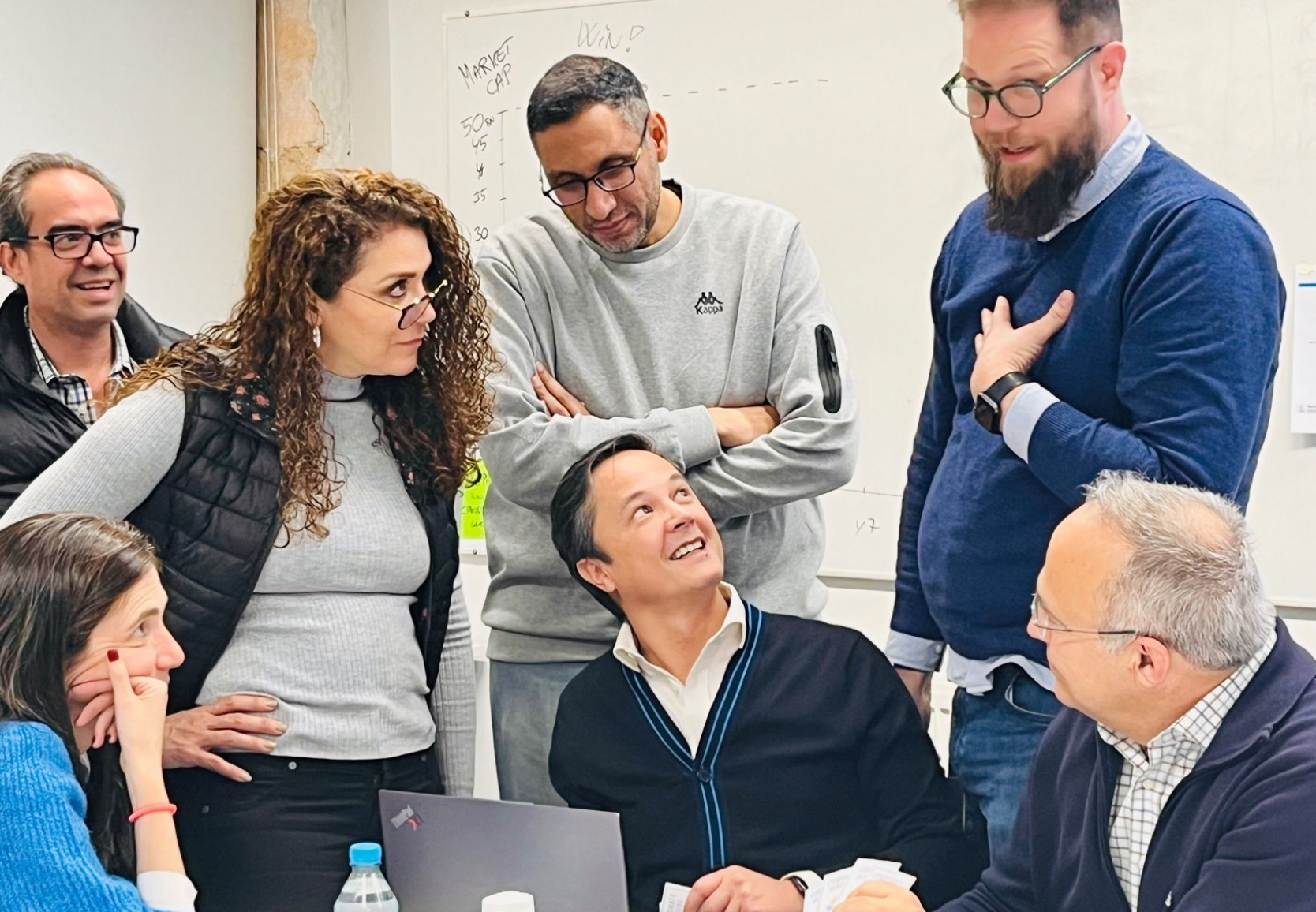
This year’s Gamechanger projects were of a disruptively high standard as always … how can we reduce the cost of cancer therapies 10 times, making them significantly more accessible to the world’s population, and at the same time helping the pharma company multiply its own market value five fold … how to convert Europe’s largest oil refineries into renewable refineries, turning captured carbon into new materials … how to use blockchain to build a fractional-owned digital infrastructure to galvanise African society … how to accelerate the development of better strains of strawberries using CRISPR … reinvent airlines with a non-volatile revenue model by developing in adjacent market … how to take Latin America’s leading retail chain to the world … create roboboats to secure the Middle East … how to develop AI-based strategy consultants … how to reinvent shrimp farming … how to optimise clean energy consumption … and much much more.
This is all built on 9 months of stimulation – bringing together the best ideas in business right now, delivered by some fantastic experts from around the world, hosted by IE Business School.
We start in the future – future back strategies, building on megatrends, embracing tech possibilities. And then to business innovation, new business models, innovation concepts, growth accelerators. And framed around the bigger idea of business transformation. All brought to life through a fabulous 8 week simulation of the future mobility sector – exec teams competing to build a $50 billion valued business, while also leading the intricacies of corporate finance, strategic disruption, portfolio growth, and how to really work as a winning c-suite team. And of course, throughout the program, lots and lots about leadership, and how to disrupt yourself to be a better leader.
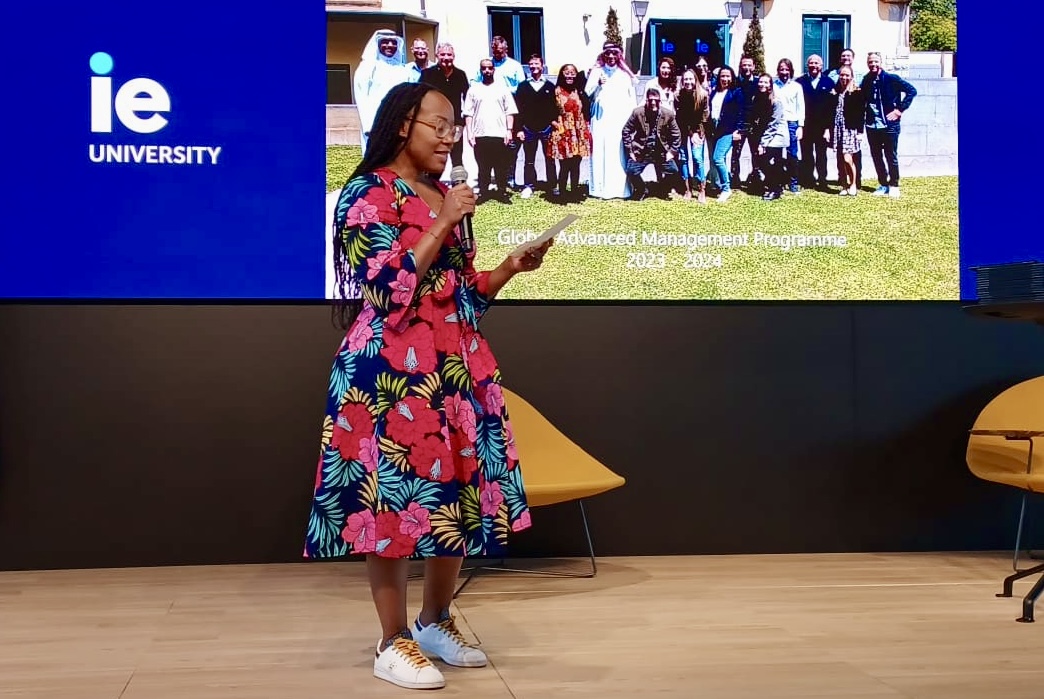
At the graduation, participants gain their wings, ready to step up as leaders of the future. We also ask them to put in words, what the program has meant to them. This year they brought together their takeaways from the program with poetic license, inspiring by Apple’s famous ad, Here’s to the Crazy Ones. It was a touching moment, a special moment for them, and myself. We’d been through so much together, and hearing how they now saw themselves, meant a lot to me:

Here’s to the transformative ones,
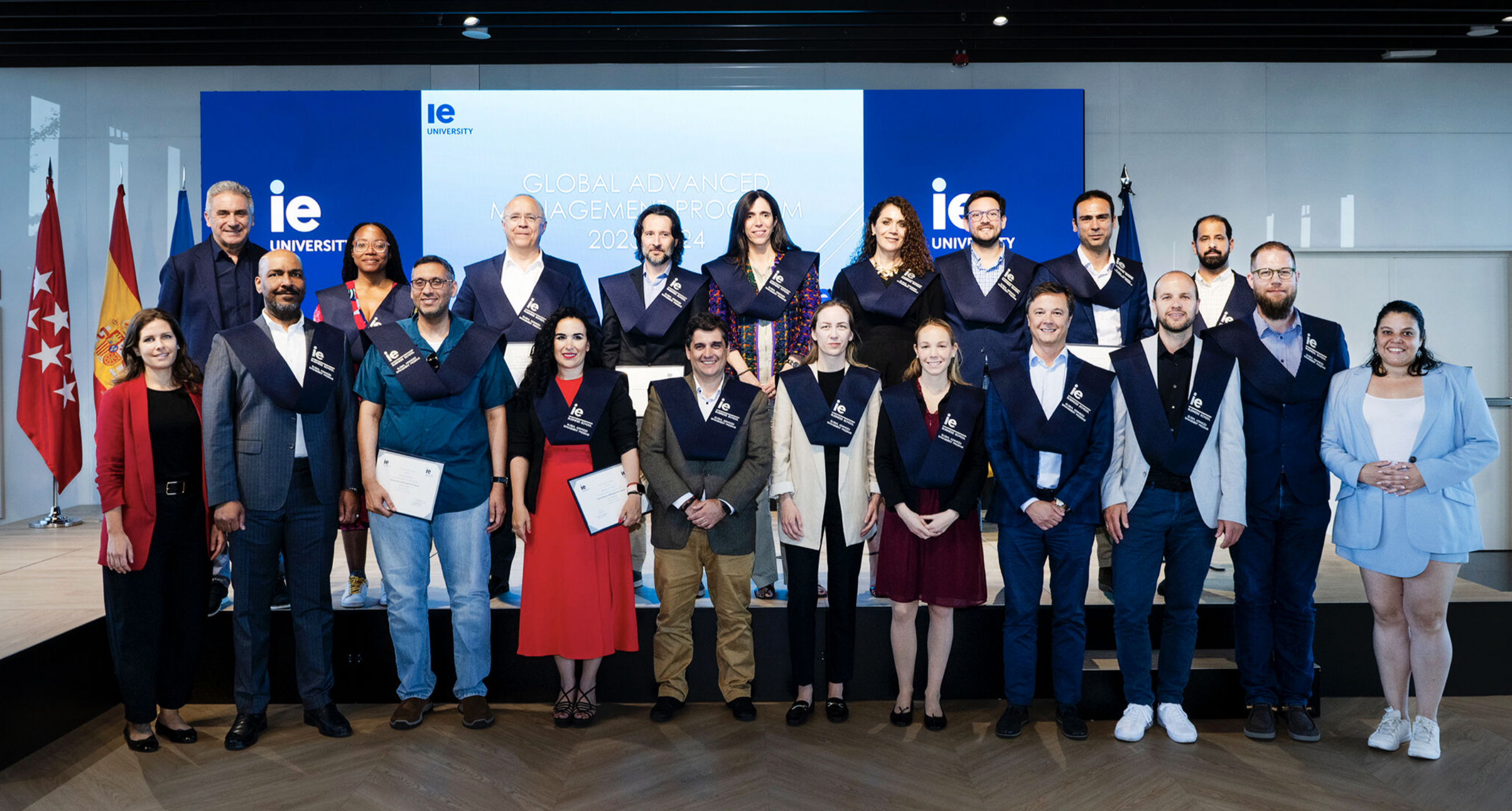
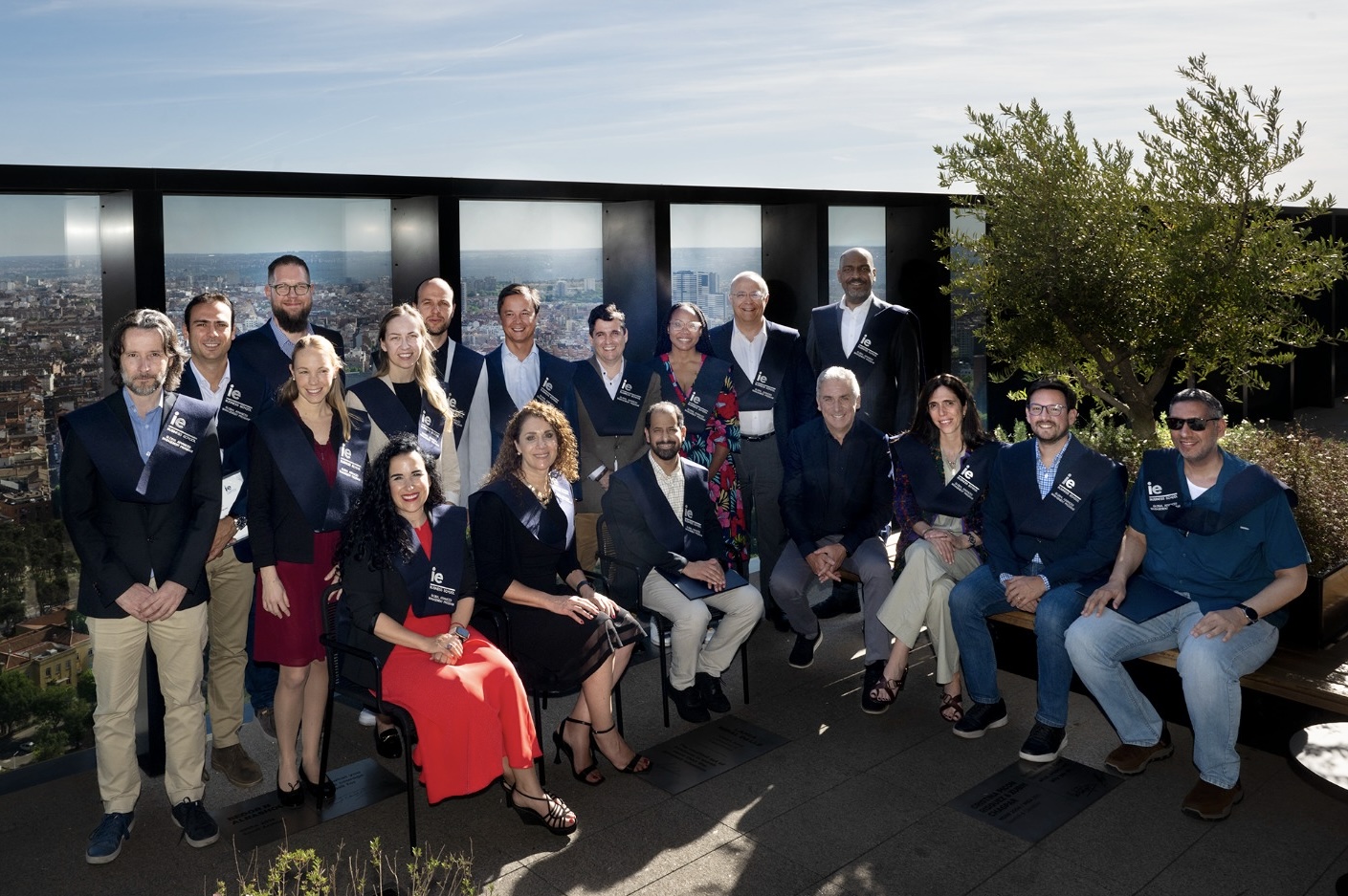
“I am a humble guy, I like to get things done, but I’m also very proud to have been ranked the world’s best CEO for two consecutive years”.
Pablo Isla is best known for his 17 year role as the Chairman and CEO of Inditex, the Spanish multinational clothing company that owns Zara, Pull & Bear, Massimo Dutti, Bershka, and many other brands. During that time he increased the market value of the business from around $15 to $85 billion.
This week at IE Business School in Madrid, where I lead their flagship executive program for business leaders stepping up to shape the future, I talked to him about his career, and in particular his approach to leadership, change and innovation.
Isla has just turned 60, and is a native of Madrid. He began his career in the legal sector, working as a corporate lawyer for various firms in Spain and the United States. He joined Inditex in 2000 as the Director of Legal Services. His deep understanding of corporate law and business strategy quickly propelled him through the ranks.
In 2005, he was asked to become the new CEO of the fast fashion company which was now one of the biggest in the world. “As a in-house lawyer I learnt a lot about the business very quickly. This meant that I could take on more operational roles because of I had a joined-up view of the business”.
5 years later, Inditex founder Amancio Ortega decided to step down as chairman, and asked Isla to step up to combine the chairman and CEO roles. “This was a huge honour” he told me. “To follow in the footsteps of a legend like Ortega was incredible. I immediately seized the opportunity to take on the responsibility of leading the business into the future”.
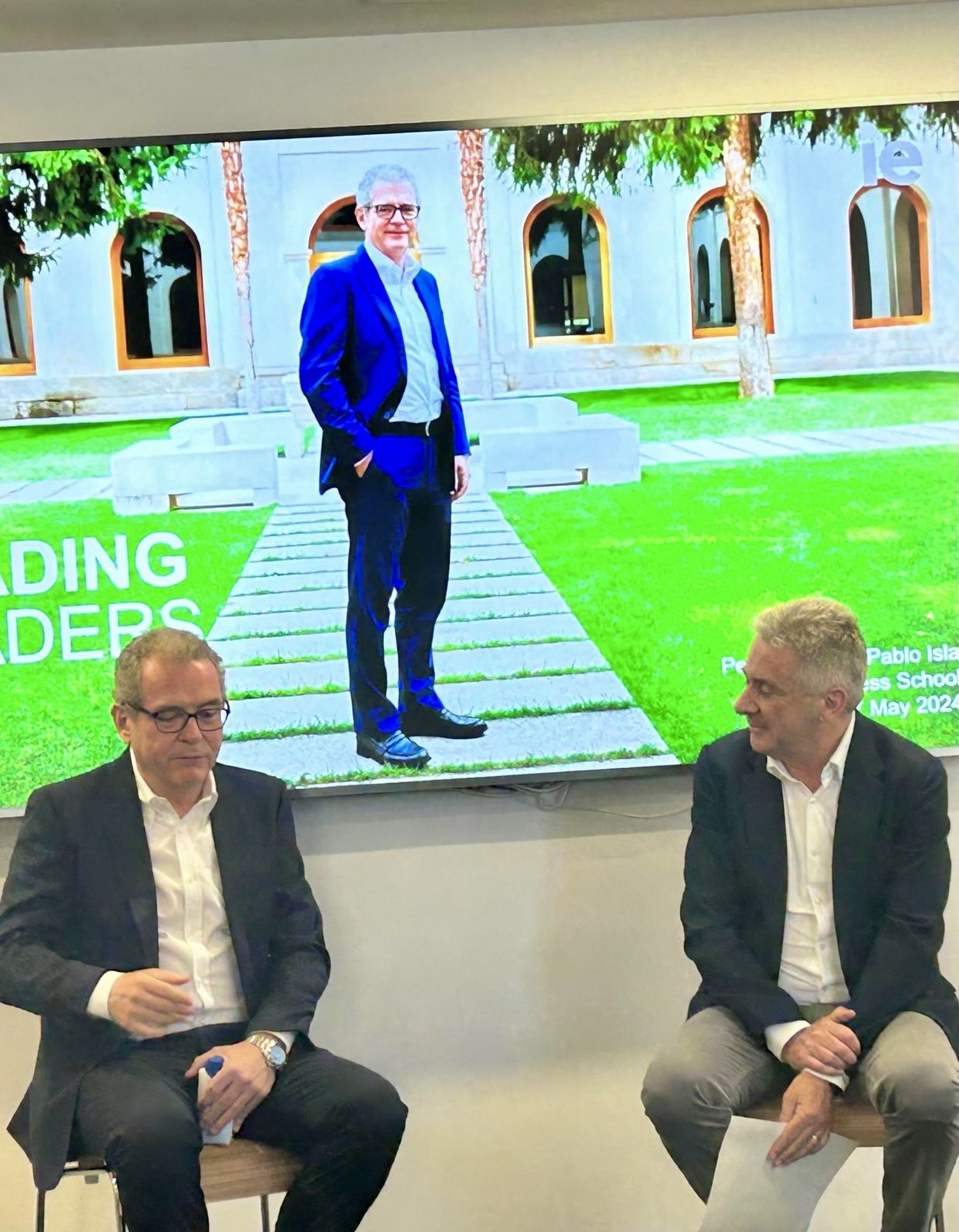
- He is widely praised for his strategic vision and leadership style. Under his leadership, Inditex has become one of the world’s largest and most successful fashion retailers.
- His strategy emphasizes a fast-fashion business model, which involves quickly responding to changing fashion trends and maintaining a high turnover of inventory.
- He is known for his hands-on approach and attention to detail. He is closely involved in all aspects of the company’s operations, from design and production to distribution and retail.
- During his 17-year tenure at Inditex, the group’s market cap rose sixfold. In 2021, his last full year leading the retailer, Inditex generated a net profit of €3.24bn on a turnover of €27.72bn.
In 2017, Harvard Business Review recognized Pablo Isla as the world’s best-performing CEO, by Harvard Business Review. And again in 2018. HBR said that what stands out is the single word description employees use to convey Isla’s management style. Humble. It’s how his employees talk about him and how he talks of his approach that’s the most telling. He is known for rejecting a meeting culture and the use of hierarchy to command, control, and ego-feed, instead favouring making decisions informally in partnership with his people as he “manages by walking around”.
In fact Isla is so notoriously shy of being in the spotlight that he doesn’t go to his own store openings. Isla described his approach to HBR: “What we want to be relevant is the company or the store opening, and everything always is the result of the work of a team of people. The strength of our company is the combination of everybody, much more than of any single person. And I can tell you that as a company, we try to be a low-profile company, being humble, of course being very ambitious, but being humble. And if we have a big store opening, we want the store to be the relevant thing, and not any particular person.”
Humble, but also very proud to have been ranked the world’s best CEO, I can tell. “When I was ranked world’s best CEO for two consecutive years, what pleased me most was that the metrics were not just financial. They also included the contribution to the environment and society”.
We talk about the current world, and the dramatic changes we are now seeing through technology, as well as through geopolitical shifts, and much more. “I don’t worry too much about everything happening around me – the markets, the competitors, the analysts” he says. Echoing the single-minded attitude of many sports people “I focus 100% on what I am trying to achieve. Not the strategies or agendas of others. The secret of leading a business is focus, focus, focus”.
I asked him what he thought of the rapid growth of Chinese “ultra-fast fashion” online retailers, Shein and Temu. Despite reaching more people than brands like Zara, he says “I am not interested in these companies, I have not looked at them in detail”.
Where he does focus, is putting the spotlight on what is most relevant to the consumer. The core shopper lusting for a $50 pair of affordable but high-fashion high heels from Zara wants to hear about the new store in her neighbourhood, not about how in control some privileged executive is. And he puts the spotlight on the most relevant employees – the front line store managers who are empowered to make product selections and whom he supports via a robust promote from within policy.
During his tenure as CEO, Inditex experienced significant growth and expansion. The company’s revenue and profits have consistently increased, and it has expanded its presence to over 7,000 stores in more than 90 countries.
Inditex’s success can be attributed to its innovative business model, efficient supply chain management, and focus on customer preferences. Under Isla’s leadership, Inditex has also prioritizsd sustainability and corporate social responsibility, implementing various initiatives to reduce its environmental footprint and promote ethical sourcing and labour practices.
His hands-on role as leader is very much about facilitated and inspiring teamwork. “The secret to getting things done is to give teams stretch and safety – plus confidence and courage”. He gave the example of launching Zara’s digital strategy. “The important thing was to make the right decision at the right time. It was crucial that we found somebody respected within the business to lead the project, and not to rush into a new idea which could alienate existing people or projects. We needed to ensure that digital added value to the existing business”.
And his view on leading in a world of relentless change? “Keep your eyes and ears open. Learn from everyone, not just in formal ways, but mostly informally. Read interesting articles, books. Meet new people, learn from other sectors”.
In 2022 he stepped down from Inditex, and reflected “After almost 20 years at the company I wanted to have more flexibility beyond always looking to the next quarterly report. It was time to hand over the business to the next generation, while also time for me to enjoy life more”. He has taken on a number of roles, including senior non-executive director of Nestle, an advisory role with private equity firm Cinvin, and chair of Italian clean energy company AmaraNZero.
“I have also started a film business, which I set up with two partners, and in which I love creative process”. Fonte Films is a production company seeking to revitalise the Spanish film-making sector. He talked about his deep passion for movies, and immediately started to share some of his favourites. I asked him whether he should have made this jump years ago, to combine his career with what he loves.
And then he pauses. “You know, what I really love is management” he said with all seriousness, and I believed him. “I love bringing teams of people together to solve problems, and to drive progress”.
This year’s Olympics were supposed to be a more inclusive and austere event, yet with the world’s largest luxury company as sponsor, they might seem like the ultimate showcase of exclusivity and wealth.
The best Moët champagne will toast the victors, as exquisitely crafted Chaumet medals are hung around their necks, by officials decked in the best of Louis Vuitton, in a sponsorship deal worth $160 million to the Olympic Organising Committee.
As LVMH described it “This global event resonates with the Group’s mission, “The Art of Crafting Dreams”. As creative partner of the Games, LVMH will play a major role by sharing the excellence and craftsmanship of its artisans for key celebratory moments throughout Paris 2024, making our Group the Artisan of All Victories.”
Olympics medals come from one of one of Paris’ most exclusive jewellers.
Conceived by the Chaumet design studio, the medals are said to convey “The Art of Crafting Dreams”. Chaumet drew inspiration from its “rich heritage, its powerfully evocative stylistic repertoire, as well as iconic symbols of France and Paris, resulting in a truly unique design that fuses tradition and modernity.”
The medals will arrive at the Olympic venue in the safety of Louis Vuitton’s most stylish luggage. While another LVMH fashion house, Berluti, is creating the uniforms that French athletes will wear during a “lavish opening ceremony on the Seine”.
Perhaps the combination of old wealth and youthful ambition is not so surprising.
Not so long ago, mass-appeal sporting events were seen as “beneath the highest-end luxury brands, which preferred to target jet-setting country-clubbers through golf, tennis, polo, sailing and Formula One.”
But in the age of social media, where athletes “seamlessly cross into the global influence market alongside pop stars and Hollywood actors,” their “reach and universal appeal has become too significant to pass up.”
Ahead of the Paris Games, Louis Vuitton sponsored a fencer and a swimmer, while Dior has backed a gymnast and a wheelchair tennis player.
LVMH’s deal “represents a delicate trade-off” as the company’s brands “cultivate a high-end image that’s potentially at odds with the idea of a toned-down Olympics.”
Changing world of LVMH
While the old world was about brand exclusivity and personal service, a boutique store on the Rue St Honoré in Paris, or Via Montenapoleone in Milan. Today’s luxury fashionistas sit online searching from their homes of Los Angeles or Shanghai.
They expect new collections as soon as they are shown in fashion shows, and personalised to their tastes. In particular the rapidly growing markets of Asia see luxury brands as a symbol of progress and status.
Bernard Arnault might be a 70-something Frenchman, but he understands this new world.
CEO of LVMH, the world’s largest luxury goods business, his personal wealth of almost $100 billion makes him the wealthiest man in Europe, and fourth richest in the world, which is not bad for an engineer who joined his father’s construction company at 22 years old.
Within a few years, Arnault already saw the world differently, persuading his father to sell the construction business and move into the real estate market. They created Férinel, a speciality vacation property business, of which he became leader in 1977, just before his thirtieth birthday. During this time, Arnault started to understand the luxury consumer, the power of brands, and how targeting premium niches could be incredibly profitable.
In 1984 he spotted an opportunity to acquire a finance company that had lost its way, but still owned some interesting assets including a rather staid and sensible Christian Dior, and department store Le Bon Marche. He quickly set about refocusing the business, and reenergising its best assets for a changing world.
The rebirth of Dior fuelled his vision and acquisition power in the luxury fashion world, and within 5 years by working with other investors, he had become the largest shareholder in the recently merged Louis Vuitton and Moet Hennesey, becoming the chairman of LVMH in 1989. The New York Times Magazine hailed Arnault a “superstar who has risen spectacularly to become head of the world’s largest luxury-goods company aged just 40”.
In the 30 years that followed, Arnault’s ambition has turned LVMH into the world’s largest luxury goods business, bringing together over 70 brands, or houses, like Givenchy and Fendi, Donna Karan and Marc Jacobs, retailers like Sephora and DFS, and jewellers Bulgari and TAG Heuer. Newer brands include Chinese red wine Ao Yun, as well as Rihanna’s Fenty Beauty range, whilst the oldest brand is wine producer Château d’Yquem, which dates its origins back to 1590.
Arnault has long realised that managing such a large and diverse portfolio requires a delicate balance of financial control and creative independence. Designers like John Galliano and the late Alexander McQueen demanded freedom to create, whilst brands in the group benefit from the long-term financial approach that can nurture brands over time, and support less profitable ones to grow stronger.
He sees LVMH as a family-business, with 4 of his 5 children working in different parts of the organisation, but also seeing all of his employees and brands as part of a long-term relationship. Indeed his motivation is much less about financial results, and much more about brand legacy, saying he is much less interested in quarterly results than he is in brand health and growth. During his leadership, however, has multiplied 20 times in value.
With rapid growth in Asia, but fairly stagnant performance in Western markets, Arnault is acutely aware of the changing global marketplace. In recent years he has accelerated online developments of each brand, often partnering with retail platforms and local businesses. He has also driven rapid growth of brand stores in major cities. With a personal fortune similar to Warren Buffett, his personal investments focus on digital businesses like Netflix and global retailers like Carrefour, keeping him tuned into a changing world.
The French billionaire likes to tell the story of how “Steve Jobs once asked me for some advice about retail, but I said, I am not sure at all we are in the same business.” However Jobs famously went on to say “You know Bernard, I don’t know if in 50 years my iPhone will still be a success but I can tell you, I’m sure everybody will still drink your Dom Pérignon.”
When someone says “grocery store,” do you instantly imagine fluorescent-lit, metal-clad buildings with soulless, towering aisles? Doing your grocery shopping is probably the least inspiring thing that you can do.
But it doesn’t have to be. What if there were stores somewhere on this planet that would stop you in your tracks to look up from your shopping list in awe and wonder?
Amazon to Buc-ee’s, Carrefour to Delhaize … Amazon continues to embed technological innovation into every aspect of its online and physical experiences, going far beyond Go. Buc-ee’s might be a gas station by definition, but is an incredible grocery store, and has just been ranked the world’s most consumer-centric brand. Carrefour redefined its entire business model around being digital first, but still a physical experience.
Whatever you think of Marks & Spencer, it’s still a great store, from the Flower Shop to Wine Shop, own-brand innovative product ranges and curated global inspirations. At Booth’s the upmarket supermarket supermarket in northern England, deli counters have been extended, hot food to go has been added and a concession partnership with the ingredients store Rafi’s Spicebox has been expanded. Customers can ask the Rafi’s employee for spice recommendations or recipe ideas, which are then paired with Booths products.
Wegmans frequently tops polls as America’s favourite grocery retailer. One of the pillars of its success is the offer of a full-service restaurant in each store, making it easier for shoppers to fit grocery shopping into their daily or weekly schedule. In addition, many of the dishes on offer are created using the Wegmans range, with the recipes available on the website or app. Stores have also been designed to resemble European open-air markets, but with extra-wide aisles and even the ability to chart a course through the store using the app or online after creating a shopping list.
Freshippo, owned by Chinese e-commerce giant Alibaba, prides itself on catering to contemporary lifestyles by fully embracing in-store, click and collect, and delivery. The Freshippo app elevates the shopping experience greatly – scan an item and the app provides recommendations on suitable food and drink pairings and then directs customers to the suggested item in-store, sends it to the till already packed or even sends it directly to the shopper’s home.Mercardo Libre continues to diversify into superapp-style categories and dominate in Latin America. And Zingerman’s, the cult grocery and food stores from Ann Arbor, continues to have a fanatical following.
- Pinduouo, shopping together, more savings, more fun: case study by Peter Fisk
- Trader Joes, local food stores with a cult following: case study by Peter Fisk
- Zingermans, a passion for food, and for people: case study by Peter Fisk
While economies are uncertain, and cost of living concerns pervade, it’s not all about price, or at least not for everyone. Latest global consumer research show that the younger and older consumers are the fastest growing segments. Young people are driven by aspiration, influence and wellness. Older people are driven by making the most of life, experiences and relationships. Which leaves the “squeezed but splurging” middle, some driven by price but still treating themselves. In general sustainability has given way to a preference for wellness, particularly amongst the young. One thing is for certain, the retail brand which tries to be average for everybody, ends up being special for nobody.
I always love a trip to Trader Joe’s when in the USA. Less of a chore, much more of an experience. I’m inspired by Coupang in South Korea, particularly its focus on technology as demonstrated by its super fast-est home delivery, and China’s incredible Pinduoduo. I love a trip to Eataly, a temple of Italian food, to buy, eat, cook, and savour. Of course, you should include q-commerce brands like Rappi, Grab and many others too as competitors, because they are in the customers eyes, offering a local convenience-driven grocery service. Or even take adjacent markets like HelloFresh and Blue Apron too.
At Edeka in Germany, even the floor tiles are working to tempt shoppers. In some stores, they advertise the availability of fresh food to go such as kebabs – and direct customers towards their whereabouts at the deli counter. Stew Leonard’s in USA takes inspiration from Disney. Singing animatronic characters, mooing cows and train sets placed overhead all play into the family-friendly ethos. “When you go shopping, you want your kids to enjoy it too,” says Chase Leonard, a third-generation member of the Leonard family.
Or if you want to see real innovation, in the most conventional grocery formats, take Spar’s flagship store in Hungary. The design, by LAB5 Architects, is as modern and as chic as it comes. If you visit here, you’ll quickly find yourself in a futuristic wooden wonderland. It feels like traversing through a space-aged cave, with wooden slats forming arches and tunnels, as well as stands for displaying goods.
Some of the most obvious trends in 2024 include:
- Improving margins: Retailers are focusing on streamlining operations, optimising supply chains, and enhancing inventory management to improve efficiency and reduce costs
- Smarter marketing: Retailers are leveraging their digital platforms to offer targeted advertising and promotional opportunities to brands, creating new revenue streams
- Personalised engagement: Adoption of technologies like AI, automation, and data analytics is driving personalised customer experiences and operational enhancements
- Healthier products: Consumers are increasingly prioritising health-conscious choices, leading to demand for organic, sustainable, and locally sourced products
- Sustainable operations: Retailers are committing to eco-friendly practices, addressing climate change, and promoting responsible sourcing.
Challenges abound amidst uncertain economic conditions:
- Loyalty without losses: loyalty doesn’t mean cheapest prices, people are engaged by emotions, loyalty cards are less about points collection more about special price treats, and services beyond products.
- Space and selection: while retailers stick to good/better/best segmentation of products, curation is even more valued, a carefully chosen limited range of brands and speciality products.
- Reducing footprint: Retailers face pressure to demonstrate genuine commitment to sustainability and reduce their environmental impact.
- Attracting staff: The industry grapples with workforce shortages, impacting store operations and customer service, linked to a shift in skills required with increasing use of tech.
- Resilient supplies: Disruptions in global supply chains require innovative solutions to maintain smooth operations, rethinking sourcing options, and business models.
Opportunities to embrace in 2024, as well as beyond:
- Doing more for you: Retailers can capitalise on the rising demand for health-focused products by offering curated selections and wellness services eg pharmacy, fitness classes, nutrition advisors, often using their own trusted brand.
- Digital-physical fusion: Combined online pre-planned and in-store top-up shopping experience, digital navigation, contactless checkouts, kerbside pick-up.
- Personalised and predictive: Leveraging AI and other technologies can enhance productivity, improve customer experiences, and drive growth.
- Transactional to experiential: From shopping based on transactions to experiences, more social, more destination-driven, more sensory, more participative, more gamified, more added-value.
- Mass to micro: Personalised offerings, local sourcing, micro fulfilment centres, and community engagement create opportunities for retailers to connect with consumers.
Explore more
- 24 for 2024: What Happens Next?
- Next is Now: How the future unfolds
- 250 Inspiring Companies to Learn From
- Deloitte Global Retail Outlook 2024
- McKinsey State of Grocery Retail in Europe 2024
- OliverWyman Future Supermarket
- PublicisSapient Store of the Future
- Making Shopping Great Again
Welcome to the future, right now.
Superfast-gaming chips and fat-busting superdrugs, asteroid-chasing rockets and carbon-capturing technologies, 4 day working weeks and chess reinvented as a reality TV game, health-enhancing fashions and the rebirth of the hairy mammoth. Nvidia is transforming tech, while Novo Nordisk innovates healthcare, KinetX changes the space race, while Climeworks eliminates carbon.
We used to marvel at innovations with a leap of imagination. Ideas and technologies that promised to transform our world, but seemed a little out of reach. Now, science fiction has collided with practical reality, powered by mind-boggling technologies that are evolving at incredible speed, but also rapid social and cultural change, accelerating human possibilities into practice.
Next is now, not only because of the pace of innovation, but also the convergence of pathways – technologies, industries, customers, applications and expectations.
What’s happening in gaming today, shapes new experiences in retail or finance. New possibilities of space travel accelerate the evolution of EVs. Clean energy meets green cement. Pharma tech meets fashion tech. Physical and digital are one, fast developing markets outpace the old stagnated developed markets, and GenZ outthink their GenX leaders.
The future is already here, even if it’s unevenly distributed. Curiosity drives creativity, enabled by new capabilities to address the biggest challenges. So what could you do? What’s your vision of next, and how do you start now?
Colossal, the de-extinction company
Colossal Biosciences seeks to reawaken the past, to bring back extinct species, to expand endangered populations through genetic rescue, to support biodiversity. In a world pushed to the brink, Colossal is optimising conservation, exogenous development, bioinformatics, modern genetics, cellular engineering, paleogenetics, biodiversity, genomics, embryology, stem cell reprogramming, computational biology, artificial intelligence, bioethics, and de-extinction.
The Austin-based genetic engineering company, founded by geneticist George Church and entrepreneur Ben Lamb, is working to de-extinct the woolly mammoth, the Tasmanian tiger, and the dodo.
Because the woolly mammoth and Asian elephant share 99.6% of the same DNA, Colossal is seeking to develop a proxy species by swapping enough key mammoth genes into the Asian elephant genome. Key mammoth genealogical traits include: a 10cm layer of insulating fat, five different types of shaggy hair, and smaller ears to help the hybrid tolerate cold weather.
Colossal launched as a fully-fledged business in 2021, with a mission to preserve endangered animals through gene-editing technology and use those same animals to reshape the world’s natural ecosystems to combat climate change.
Colossal’s lab will pair CRISPR/Cas9 with other DNA-editing enzymes, such as integrases, recombinases, and deaminases, to splice woolly mammoth genes into the Asian elephant. The company plans on sequencing both elephant and mammoth samples in order to identify key genes in both species to promote population diversification. By doing so, Colossal hopes to prevent any rogue mutations within the hybrid herd.
Back in a 2008 interview with The New York Times, George Church first expressed his interest in engineering a hybrid Asian elephant-mammoth by sequencing the woolly mammoth genome. In 2012, Church was part of a team that pioneered the CRISPR-Cas9 gene editing tool, through which the potential for altering genetic code to engineer the envisioned “mammophant” surfaced. He presented a talk at the National Geographic Society in 2013, where he mapped out the idea of Colossal.
Church and his genetics team used CRISPR to copy mammoth genes into the genome of an Asian elephant in 2015. That same year, his lab integrated mammoth genes into the DNA of elephant skin cells; the lab zeroed in on 60 genes that experiments hypothesized as being important to the distinctive traits of mammoths, such as a high-domed skull, ability to hold oxygen at low temperatures, and fatty tissue. By 2017 it had successfully added 45 genes to the genome of an Asian elephant.
While Colossal’s de-extinction business might seem like science fiction, the latest movie from Jurassic Park, it echoes the progress by companies like CRISPR Therapeutics in Zurich, led by Nobel prize winner Jennifer Doudna, who applying the same science to humans. With all the same technical and ethical challenges which it brings. It also demonstrates how rapidly ideas of fiction are now becoming reality.
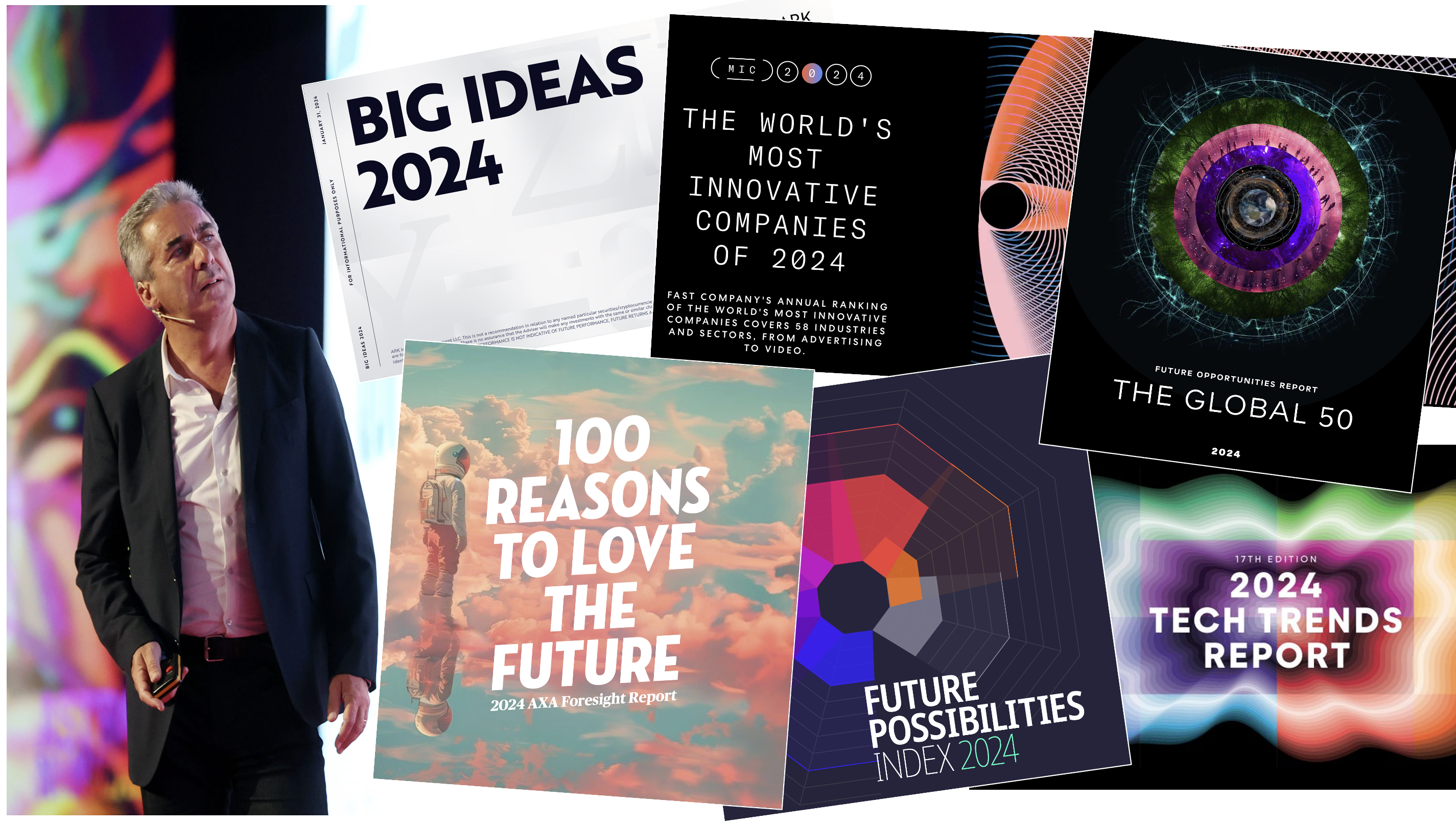
- Big Ideas Report 2024 … how tech is transforming business
- Future Possibilities Index 2024 … the next economies emerging right now
- Global 50 Opportunities 2024 … megatrends driving new opportunities
- 100 Reasons to Love the Future … new narratives that give hope amidst uncertainty.
Innovations enabled by incredible technologies
The new Big Ideas report by ARK Invest captures the disruptive impact of technologies right now. It suggests that by 2030, the convergence of 5 significant technologies, accelerated by artificial intelligence, will have an unprecedented economic impact. AI provides the “intelligent glue” to bring together the potential of public blockchains, multigenomic sequencing, energy storage, and robotics, in a way that could transform global economic activity more significantly than any previous industrial revolution.
Globally, real economic growth could accelerate from 3% on average during the past 125 years to more than 7% during the next 7 years as robots reinvigorate manufacturing, robotaxis transform transportation, and AI amplifies knowledge worker productivity.
As a result the global equity market value specifically associated with disruptive innovation could increase from 16% of the total to more than 60% by 2030, resulting in annualised equity returns of 40%, or increasing the total market capitalisation driven by disruptive tech from $19 trillion today to roughly $220 trillion by 2030.
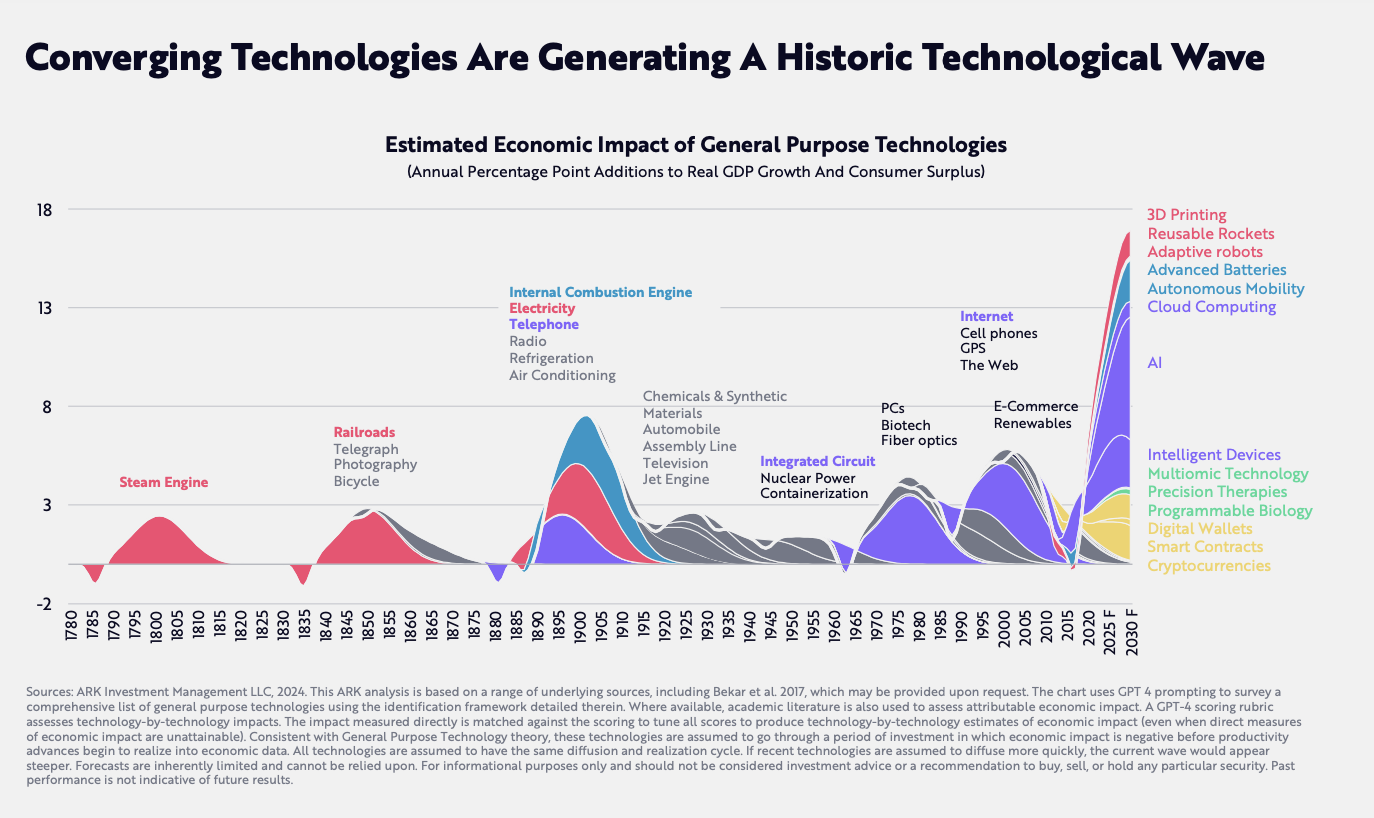
The Future Possibilities Index 2024 also explores the applications of these fast-emerging tech, and how they will shape new economies. It focus on 6 transformational trends that are creating possibilities and the factors that determine our readiness and capacity to leverage these trends over the next 5-10 years. All have emerged from a combination of new business models, technologies, and changes in attitudes and behaviours. The six trends are the Exabyte Economy, the Wellbeing Economy, the Net Zero Economy, the Circular Economy, the BioGrowth Economy and the Experience Economy.
Fast Company’s latest ranking of the world’s Most Innovative Companies 2024 showcases some of the most exciting innovators who are both driving this tech acceleration, and embracing its benefits. While BCG also produces an innovation ranking each year, quantitatively evaluating the R&D efforts of corporations, the FC version is far more insightful, about the people driving the innovations, and the solutions that are emerging.
This year’s #MIC24 ranking includes:
- Nvidia is riding a wave of warp-speed AI progress, having lagged far behind Intel for decades, Jensen Huang’s $1.5 trillion business which he founded in 1993 on his 30th birthday, leapt ahead of tech monoliths like Alphabet and Amazon in recent months, driven by the rush for high-powered immersive gaming, and the relentless growth of AI.
- Novo Nordisk found in its latest diabetes drug Ozempic, an obesity-busting sensation, that together with its lower dosage sister-brand Wegovy, has taken the world by storm. The Danish pharma business can’t make enough of it, and has soared to become Europe’s most valuable company, and more valuable than Denmark’s entire GDP.
- Perplexity is creating an entirely new way to search the web, by leveraging AI to provide more contextualised and accurate answers, rather than a list of relevant links. It uses a combination of homegrown large language models (LLMs) and third-party models (like OpenAI’s GPT-4) plus retrieval-augmented generation (RAG).
- KinetX helped navigate a spacecraft on a 4.4 billion-mile mission to land on an asteroid and return home. Founded in 1992 as a spinoff of Lockheed Martin, it is partnering NASA on deep-space missions like New Horizons (to Pluto, then the edge of the solar system) and Messenger (orbiting Mercury for the first time).
- Climeworks uses direct air capture to scrub carbon from the atmosphere. It operates the world’s largest DAC plants, both in Iceland, which remove around 10,000 tons of CO2 from the atmosphere every year—and about half of that is being done by the Zurich-based DAC pioneer.
Innovations enabling radically better lives
The new Global 50 Opportunities report by Dubai Future Foundation takes a global perspective on the innovative applications emerging from a rapidly changing world, partly driven by technologies, but much more too.
It starts by exploring the megatrends which it sees as most influential right now, and then how these are unlocking 50 opportunities for future growth, prosperity and well-being. Some opportunities may be in their early days of exploration, some require reflection, and some feel very far away. “Shaping the future cannot be done by just waiting for it but rather by utilizing the latest technologies and knowledge tools and meeting its challenges starting from today.”
The 8 megatrends include materials revolution (from which opportunities emerge like 3d printing of human organs, green plastics, and fashion with embedded health benefits), future humanity (school for wisdom, open source science, and flipping career ladders), and advanced health (mental AI, pulse over pills, and biohacking 2.0). These are just a few examples (dive into the digital report to explore the opportunities in more detail):
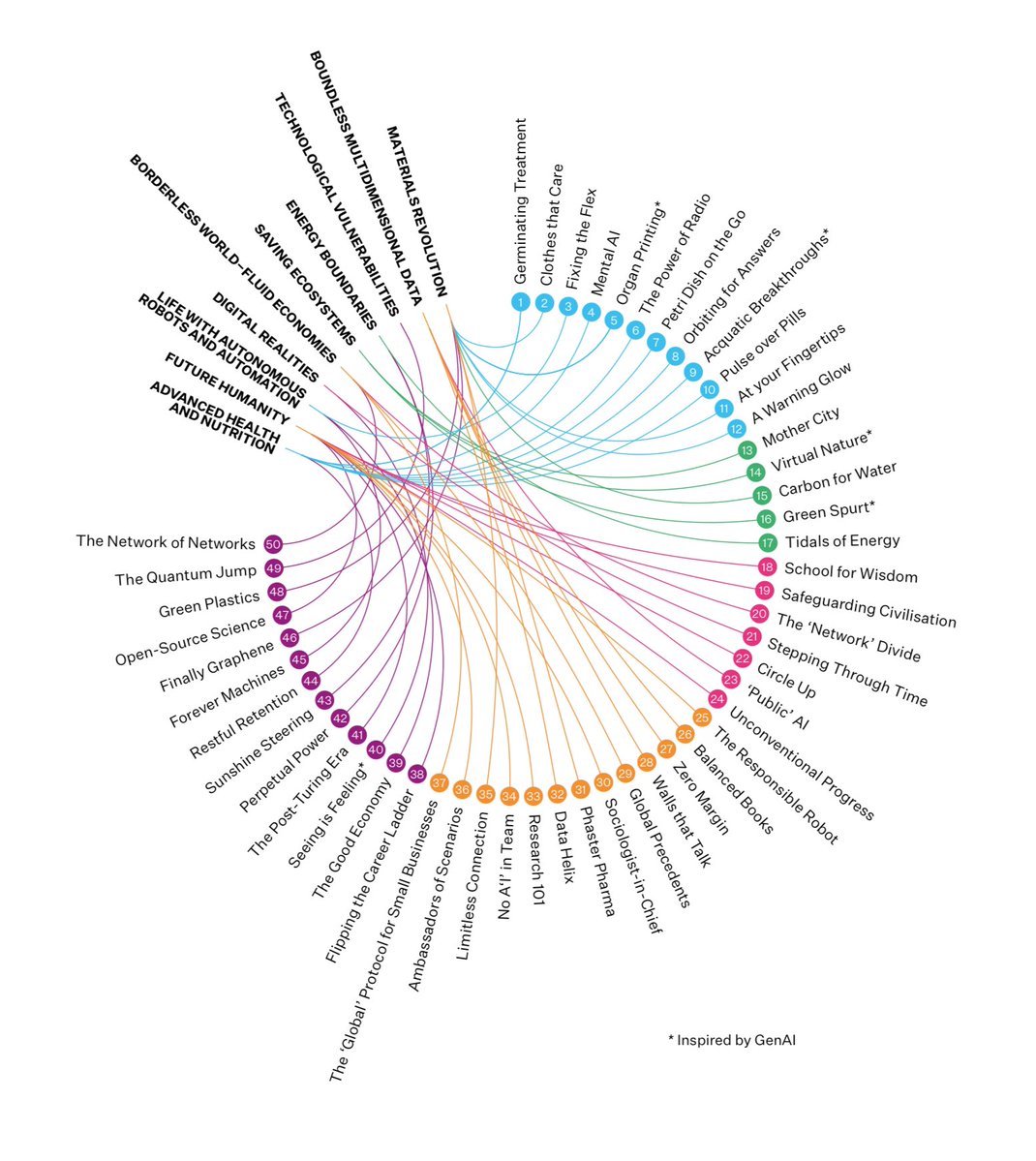
100 Reasons to Love the Future is a fabulous new report from AXA’s foresight team, promising “new narratives of hope” and inspiring us to “imagine utopia rather than retreat to dystopia”. The report argues that in a world of escalating risks, our societies and economies cannot afford to become paralysed by uncertainty. We are all living through a deep transformation. Far better to embrace it than retreat into anxiety and doubt.
In the midst of the 100 reasons is a great insight from Plurality University about what organisations could look like in 2050 – from the Marketrix to the Reactivator, the Enterpocine and the Zombinc. There’s also a great insight about Te Korekoreka, and navigating futures with Māori Wisdom. The New Zealand initiative uses social innovation to achieve equity in education, employment, and income for Māori people. And much more, a great report!
Take another look at Fast Company’s Most Innovative Companies 2024 list, and beyond the big names like Nvidia you will find a wealth of smaller companies making significant human impacts, harnessing tech for good, rather than just for tech. Yet the new tech capabilities are incredible, providing new ways to solve some of the biggest problems; while also shaping cultures through exponential social influence; and enabling people to access, and do, what they could never before:
- Solfácil the Brazilian solar investment company is bringing solar power to people living in the Amazon, and has financed approximately $450 million in solar loans, working with more than 4,250 active solar installers and has 66,000-plus customers to date.
- 4 Day Week Global convinced companies around the world to adopt a shorter work week, the nonprofit brought together hundreds of companies to create a post-pandemic revolution in the workplace, encouraged by its research which showed that a 4 day week delivered an average 36% rise in revenue.
- Chess.com is turning a centuries-old game into must-see reality TV. The freemium chess platform logged more games played (12.5 billion) than ever before, while establishing itself as the game’s cultural hub, full of everything from news to memes to the best Twitch streamers.
- Sea Forest, a Tasmanian business which scooped the 2023 Earthshot Prize, has a seaweed supplement to stop cows from burping up methane. It is the first company in the world to farm methane-busting Asparagopsis, a red seaweed native to Australian coastal waters, reducing methane production by up to 90%.
- Mattel took its 65 year old Barbie dolls and turned the brand into a $1.4 billion global movie blockbuster, the highest grossing film of 2023, with a series of agenda-setting messages not just saccharine sassiness, and became a cultural event that attracted diverse audiences, plus all types of pink-coloured spinoffs.
So while the world of technology is complex and relentless, with profound questions about ethics and humanity, our rapidly changing world can also be deeply human, sometimes frivolous, sometimes profound.
The opportunities to innovate are everywhere. And while average, old markets might seem to have stagnated, the world continues to move forwards at incredible pace. We have huge challenges, where issues like climate change will only be conquered with radical new thinking, and enabled by new technologies.
We also have an opportunity to create a happier, healthier world. Embrace utopia, don’t retreat to dystopia. By jumping to the future we can see problems differently, the impossible becomes possible, and we can accelerate progress.
Next is now. There is only ever today. Let the future begin.
Explore more
- 24 for 2024 … new ideas, new innovators, new possibilities
- Future Recoded … an online learning and knowledge platform
- Trend Kaleidoscope 2024 … curating all the best trend reports
- Megatrends and Strategies … defining your future strategy roadmap
- Waveriders and Transformers … developing leaders as future makers
- Future Radar of Trends and Innovations … analytical futures toolbox
The high octane world of corporate boardrooms making billion-dollar decisions, and entrepreneurial start-ups obsessed with getting there, is rife for movie-making. And indeed some of the most thrilling movies of recent years are also stories of business, how they soared and sometimes fell, and the personalities behind them.
Here’s my pick of the best business movies, each worthy of an MBA class:
Air … the story of Nike’s Air Jordan
Exploring the partnership between a then rookie Michael Jordan and Nike’s fledgling basketball division which revolutionised the world of sports and contemporary culture with the Air Jordan brand. This moving story follows the career-defining gamble of an unconventional team with everything on the line, the uncompromising vision of a mother who knows the worth of her son’s immense talent, and the basketball phenom who would become the greatest of all time (Warner Bros, 2023).
The Aviator … the story of TWA
The Aviator tells the story of Howard Hughes, a wily industrialist, glamorous movie producer and unstoppable American innovator – but thought of himself first and foremost as an aviator. In this spectacular epic, director Martin Scorsese focuses on the most prolific period in the life of Hughes: the mid-1920s through the 1940s. It was a time of brilliant aeronautical invention, turbulent love affairs and savage corporate battles. (2004)
The Billion Dollar Code … the story of Google Earth
Two German computer pioneers who go to court in the fight against an apparently invincible opponent in order to be recognized as the inventor of the Google Earth algorithm. The series illuminates both the hacker scene in post-reunification Berlin in the 90s, as well as the idealistic world of early Silicon Valley and the harsh reality of a multi-million dollar process. (2021).
The Big Short … the story of investment banking
“You smell that? What is that?… “Your cologne? … No … Opportunity … No. Money” … When four outsiders saw what the big banks, media and government refused to, the global collapse of the economy, they had an idea: The Big Short. Their bold investment leads them into the dark underbelly of modern banking where they must question everyone and everything. Based on the true story and best-selling book by Michael Lewis. (Paramount, 2016)
The Founder … the story of McDonald’s
Starring Michael Keaton as businessman Ray Kroc, the film depicts the story of his creation of the McDonald’s fast-food restaurant chain, which eventually involved forcing out the company’s original founders to take control with conniving ruthlessness (2016).
An Inconvenient Sequel … the story of climate change
A decade after An Inconvenient Truth brought climate change into the heart of popular culture, comes the follow-up that shows just how close we are to a real energy revolution. Al Gore continues his tireless fight traveling around the world training an army of climate champions and influencing international climate policy. Cameras follow him behind the scenes, in moments both private and public, funny and poignant, as he pursues the inspirational idea that while the stakes have never been higher, the perils of climate change can be overcome with human ingenuity and passion. (Paramount, 2017)
The Inventor … the story of Theranos
The Inventor chronicles the rise and fall of Theranos, interspersed with footage of Holmes and her COO Sunny Balwani making grandiose proclamations about Theranos and the value it was providing. It also includes visual flashbacks to the era of Thomas Edison, the titular Inventor who famously failed repeatedly before finally succeeding; Theranos’s miniature blood testing labs were called “Edisons”. In 2022 Holmes was convicted of defrauding investors, and sentenced to serve 11 years in prison. (HBO, 2019).
Moneyball … the story of Oakland Athletic
The story of Oakland Athletic, based on book Moneyball: The Art of Winning an Unfair Game by Michael Lewis. It is the baseball team’s 2002 season and their general manager Billy Beane’s attempts to assemble a competitive team. In the film, Beane, played by Brand Pitt, is faced with the franchise’s limited budget for players, build a team of undervalued talent by taking a sophisticated analytical approach to scouting for the best talent.
The Playlist … the story of Spotify
At the height of piracy, established heavy-hitters were fighting against where the turbulent music industry was heading. The series centers around young Swedish tech entrepreneur, Daniel Ek, and his partners, who revolutionized a whole industry by offering free and legal streamed music around the world. (Netflix 2022)
Seaspiracy … the story of unsustainable fishing
11,000 to 30,000 sharks are killed by humans every hour of every day, totally around 4.5 million a year. Almost half are killed as bycatch and discarded back into the ocean. Seaspiracy examines the global fishing industry, challenging notions of sustainable fishing and showing how human actions cause widespread environmental destruction. (Netflix, 2021)
The film examines the 2001 collapse of the Enron Corporation, which resulted in criminal trials for several of the company’s top executives; it also shows the involvement of the Enron traders in the California electricity crisis. The film features interviews with McLean and Elkind, as well as former Enron executives and employees, stock analysts, reporters and the former Governor of California Gray Davis. (2005)
The Social Network … the story of Facebook
The tale of a new breed of cultural insurgent: a punk genius who sparked a revolution and changed the face of human interaction for a generation, and perhaps forever. Shot through with emotional brutality and unexpected humour, this superbly crafted film chronicles the formation of Facebook and the battles over ownership that followed upon the website’s unfathomable success. (Sony, 2010)
Steve Jobs … the story of Apple
Set backstage at three iconic product launches and ending in 1998 with the unveiling of the iMac, Steve Jobs takes us behind the scenes of the digital revolution to paint an intimate portrait of the brilliant man at its epicenter. Michael Fassbender plays Steve Jobs, the pioneering founder of Apple, with Kate Winslet starring as Joanna Hoffman, former marketing chief of Macintosh.
Super Pumped … the story of Uber
The ambitious CEO Travis Kalanick of ride-hailing app Uber tries to turn a struggling startup into a tech titan amid massive scandals, and is ultimately ousted in a boardroom coup. The series embodies the highs and lows of a Silicon Valley start-up. (2022).
WeCrashed ... the story of WeWork
Inspired by actual events, and the love story at the centre of it all. WeWork grew from a single co-working space into a global brand worth $47 billion in under a decade. Then, in less than a year, its valuation dropped $40 billion. What happened? Starring Jared Leto as Adam Neumann, Anne Hathaway as Rebekah Neumann and Kyle Marvin as Miguel McKelvey.
And a few great videos …
The Joy of Stats … by Hans Rosling
The late Hans Rosling’s famous lectures combined enormous quantities of public data with a sport’s commentator’s style to reveal the story of the world’s past, present and future development. He explored stats in a way he has never done before – using augmented reality animation. In this spectacular section of ‘The Joy of Stats’ he tells the story of the world in 200 countries over 200 years using 120,000 numbers – in just four minutes. Plotting life expectancy against income for every country since 1810, he shows how the world we live in is radically different from the world most of us imagine. (BBC, 2011)
Brené Brown studies human connection, our ability to empathise, belong, love. She is an American professor, social worker, author, and podcast host, known for her work on shame, vulnerability, and leadership, In a poignant, funny talk at TEDxHouston, she shares a deep insight from her research, one that sent her on a personal quest to know herself as well as to understand humanity. (TED, 2011)
Is this how our story is due to end?” … by Sir David Attenborough
In an electrifying speech delivered at the opening of the World Leaders Summit on Climate Change (COP26) in Glasgow, Attenborough gave a message of hope on behalf of the world that through action, we will witness the recovery of the natural world. But his warning of what will follow should we fail to act was also clear and stark. His speech was illustrated with stunning, cinematic pictures shown on giant screens behind him, produced by Silverback Films.
Looks Aren’t Everything … by Cameron Russell
The supermodel admits she won “a genetic lottery”: she’s tall, pretty and an underwear model. A Victoria’s Secret favorite, she has appeared in multiple international editions of Vogue as well as in ads for brands like Ralph Lauren and Benetton. But she feels at her core that image isn’t everything. But don’t judge her by her looks. In this fearless talk, she takes a wry look at the industry that had her looking highly seductive at barely 16-years-old.
Grit: The power of passion and perseverance … by Angela Duckworth
Leaving a high-flying job in consulting, Angela Duckworth took a job teaching math to seventh graders in a New York public school. She quickly realized that IQ wasn’t the only thing separating the successful students from those who struggled. Here, she explains her theory of “grit” as a predictor of success.
The Puzzle of Motivation … by Dan Pink
Dan Pink examines the puzzle of motivation, starting with a fact that social scientists know but most managers don’t: Traditional rewards aren’t always as effective as we think. Listen for illuminating stories, and maybe, a way forward. Dan Pink is the former speechwriter to Al Gore. His books include A Whole New Mind on why right-brainers will rule the future, and Drive exploring the surprising truth about what motivates us.
Dare to Disagree … by Margaret Heffernan
Most people instinctively avoid conflict, but as Margaret Heffernan shows us, good disagreement is central to progress. She illustrates (sometimes counterintuitively) how the best partners aren’t echo chambers — and how great research teams, relationships and businesses allow people to deeply disagree. (TED, 2012)
As the human population continues to grow, so does our impact on the environment. In fact, recent research has shown that three-quarters of Earth’s land surface is under pressure from human activity. In this short film, spoken word artist Prince Ea makes a powerful case for protecting the planet and challenges the human race to create a sustainable future. (National Geographical, 2017).
The book publishing industry is in a bind.
While the world changes – as digital platforms transform every other industry, as new generations engage in new ways, as the sources of value are rapidly upturned – the world of books continues to dismiss the need for real change.
Maybe technology can automate some of the slowest processes, maybe AI can improve production efficiency, maybe tweaks can reduce waste and improve sustainability, but most publishers still like books – ideally 300 pages, black and white, standardised format, hard back.
Of course there is a cultural love of printed books, the antiquated romance of literature, the refuge of an old book shop, the comfort of a physical tome. And, in fact, more books were sold across the world than ever before.
But it’s a pure fantasy to assume this can be the future.
All around, every industry has changed. 25 years ago, platforms like Amazon and Netflix challenged the old world of retail and entertainment. Now they are the establishment.
In a world of smartphone primacy … where payments are a digital click, retail is gamified entertainment, pizzas are delivered in minutes, events are personal and immersive, relationships are social, and influence is communal … isn’t it time for books to innovate?
The publishing world, more generally, woke up long ago.
News is live across multiple channels, movies are on demand, advertising is programatic. Time Magazine to Rolling Stone are delivered by monthly download, with daily updates. Many young people have never even watched a scheduled TV program, or read a newspaper.
Book publishing requires more than tweaks to its old model. Tweaks to reduce costs, increase speed, embrace social, are just tweaks. Diminishing returns in an outdated world.
Publishers need new business models
New business models are the most effective way to transform organisations, to innovate the whole way in which the business works. Inspired by a new generation of businesses – Airbnb to Uber, Revolut to Netflix – we see dramatically new business models in every market, through collaborative platforms, data analytics and personal recommendations, or subscription-based payments.
Airbnb makes money by helping you to make money out of your spare room, connecting host and guest, then taking a small fee from each. Nespresso makes great coffee, selling discounted machines, and then getting you to sign up to an everlasting and incredibly profitable direct revenue steam of coffee pods.
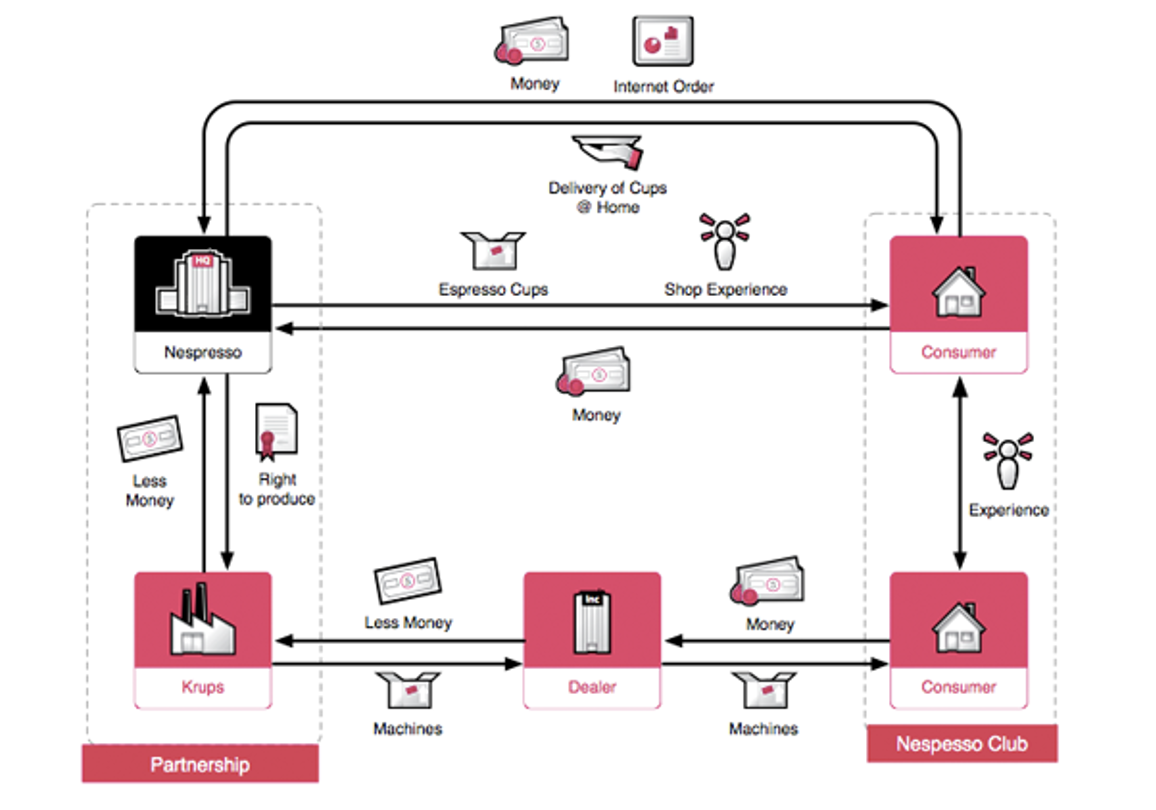
What if your business started leasing rather than selling, became part of the sharing economy? What if you simply facilitated an exchange between buyers and sellers and took a cut? How about moving to a subscription model, or a freemium model, or a referral model, or an advertising model?
The term “Business Model” is over used and under defined. Business models explain how organisations work – how do they create value for customers, and in doing so how they create value for all other stakeholders. They can map the current business, or explore options for the future.
The approach originates from mapping “value networks” in the 1990s, understanding the systems across business and its partners through which value (both financial and non-financial) is created and exchanged – by who, how and for whom. I remember working with Pugh Roberts to create a multi-million dollar dynamic model for Mastercard which showed varying any one driver – such as interest rates, or branding – affected everything else. And thereby being able to test new ideas and optimise the model.
Business models represent the dynamic system through which a business creates and captures value, and how this can changed or optimised. They are a configuration of the building blocks of business, and their creative reconfiguration can be a significant innovation.
Business models became fundamental to business strategy, driven by them but often driving them. Hambrick and Fredrickson’s Strategy Diamond is all about aligning the organisation, achieving an economic logic between strategic choices. They help to align the business, matching the right strategies for outside and inside, using the proposition as the fulcrum, and profitability as the measure of success.
Business models can often appear very mechanical, lacking emotion and easy to imitate. In 2001 Patrick Staehler, in particular seeking to explain the new breed of digital businesses, created a business model “map” driven by the value proposition, enabled by the value architecture, creating economic value and sustained by cultural values. The last point here is most interesting, in that it captured the distinctive personality of a business, its leadership styles and ways of doing business. This is much harder to copy, and also sustains the other aspects.
Alex Osterwalder’s subsequent Business Model Canvas emerged as the most common template on which to map a business model. He popularised the approach so much so that his supersized canvas now features in workshops throughout the world, always with an array of multi coloured sticky notes as teams debate the best combination of solutions for each box. Whilst the canvas lacks the sophistication of value driver analysis and dynamic modelling, it is about testing hypothesise in each aspect, and how they could work together, and that respect works as a thinking model.
Business models have become a practical tool for rethinking the whole business, seeing the connections and then innovating the business. In fact they offer a great platform to facilitate new strategy and innovation thinking. That’s why we’ve created the Business Innovation Program, which combines design thinking, new business models and strategic implementation – a great way to engage your team, to think about new ways to grow, and to create the future, practically.
We explore at least 50 different business model templates which could transform your business. We start with the customer, to explore emergent needs and behaviours, shaping better propositions and solutions, then exploring how to deliver them commercially, and as engaging customer experiences.
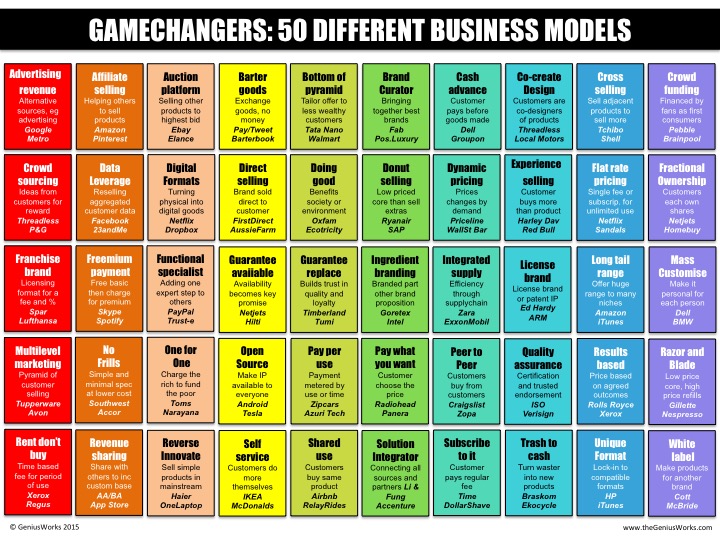
Here are some examples from other areas of publishing. This is by no means an exhaustive list, as the variations are infinite, and may involve components of multiple examples:
The Paid Content Publisher: Subscriptions or micropayments
- Targets the loyal, demanding consumer who values the objective and relevant content that top news outlets produce
- Examples: The Economist in media publishing, Blinklist in digital book summaries.
- They are clearly the world leaders with the highest credibility, coverage and loyalty from their audiences. Through various forms of payment for content they have been able to sustain their business model. Only those with good quality journalism and community engagement are able to survive with this model.
The People’s Publisher: Crowdfunding
- Targets the consumer who is willing to fund media companies with negative balances, supporting their clear independence and good quality, credible content.
- Examples: Unbound in book publishing, The Guardian in media publishing.
- This business model is recommended for kick-starting a business or a specific
project, with a goal of then achieving sustainability through another model such as advertising or subscriptions. Only in very well developed economies will this model be able to grow. Regulatory restrictions still limit the use of crowdfunding.
The Self Publisher: Author published
- Targets consumers who are highly segmented, and in a database built up by the author already, without the need for publisher brand endorsement
- Examples: Amazon Kindle, Apple Books
- These platforms have a a DIY platform to enable authors to develop, format, prepare, and produce their books for significantly lower fees. It may include hybrid models which can involve freelance designers, copywriters, being part of the process. The platform may then also distribute the book to its audience, for a relatively minimal fee.
The Custom Publisher: On demand, asset based
- Targets specialist audiences who only want to buy specific content (eg individual chapter, or entity), or want it customised in some way specific to them (eg personal name inserted, corporate branded etc)
- Examples: Publishers House,
- These platforms are often linked to self publishing, but could work for any book. The concept of buying a book by a chapter, or selection of chapters unto the full price of the book can work well in technical subjects. Print on demand technologies in general, allow publishers to access their huge back catalogues of content and titles, without having them preprinted and stored. Also to print on location, to avoid shipping.
The Retailer Publisher: Vertical, ecommerce
- Targets consumers who are highly segmented due to their needs and profile and who are willing to satisfy their purchase needs with the portfolio of products / services offered.
- Examples: Monocle in media publishing, Net-a-Porter in fashion publishing
- These companies have clearly focused on a niche audience with both content
and exclusive and attractive offers, which has increased the purchase intent for their products and captured the advertisers’ interest. With the gradual increase of e-commerce in the retail market, more companies will have to develop this model, independently or through partnerships. A deep understanding of their audiences is a must to survive with this model.
The Events Publisher: Events, experiences
- Targets consumers attracted by the quality and credibility of the brand and their resulting events
- Examples: Ascential in events publishing (Cannes Lions etc), Live Nation in music
- These companies have consolidated the development of events of all their brands into a single area for the sale of tickets and sponsorships or have opted to create independent business units aligned with the growing interest of the consumer in actively participating in new experiences. These events also generate new content, data that feeds databases and become positive influencers for their brands. This model could represent 20 per cent of total revenues with good brand partnerships and with the right management team.
The Community Publisher: Clubs, membership
- Targets consumers who, through subscription packages, not only access editorial products, but attractive discounts in a broad portfolio of products and services. The annual subscription could be recovered through accessing these discounts.
- Examples: The Atlantic in sports publishing, Future in media publishing (eg Americas Test Kitchen)
- All these companies have generated a robust list of benefits so that subscribers have preferential access to relevant events, premieres and discounts across a wide range of services. It requires a proactive telemarketing strategy to make sure that the club members are satisfied and loyalty prevails.
The Advertising Publisher: Advertising, branded content
- Targeting interested advertisers to build and distribute relevant messages associated with their brands and the needs of the audiences
- Examples: Quartz, British Airways High Life
- These companies are among the few that still survive with robust models dependent on advertising, due to their high segmentation and profiling of their audiences which capture sophisticated audiences.
The Agency Publisher: Selling brand content
- Targeting advertisers who do not have the capacity to contract creative agencies to create advertising pieces for their audiences.
- Examples: 23stories by Condé Nast, CNBC Catalyst
- Taking advantage of their content creation potential, these companies have built creative and editorial teams to design 360 marketing campaigns and branded content production for advertisers, that can be disseminated through their media portfolio. It requires leveraging the competency of the marketing team to be able to compete against traditional ad agencies with cost-effective strategies and excellent service level agreements.
The Database Publisher: Data broker
- Targeting advertisers who want to increase their effectiveness in advertising campaigns with databases generated from the media companies’ audiences.
- Examples: ProPublica (US), Schibsted (Norway)
- With the emergence of programmatic advertising, it becomes increasingly important to have your own data, to be able to take advantage of them internally but also to offer them to third parties to increase the effectiveness of your marketing campaigns. Classified ads and verticals are also an excellent vehicle to enlarge databases with more relevant audience information.
The Licensing Publisher: Innovating services
- When the intangible value of the brand is high, it is worth taking advantage of this to license the brand in other related products or services, and thus obtain other related sources of income
- Examples: Disney, National Geographic
- All these brands enjoy great recognition, credibility and acceptance by their audiences. By developing new products and services with this seal of quality, they can generate additional income. In most countries, media companies have a good brand awareness and acceptance; an intangible asset that can be wisely used to enlarge revenue sources with complementary businesses.
The IT Publisher: Selling software
- When internal IT development has proved to be effective, media companies can offer consulting and IT licensing services to their industry peers to increase their operational efficiency.
- Examples: The Washington Post with ARC
- Unfortunately, not many media companies have the capability to offer these types of services. This model requires developing a business-oriented and a consultative selling and consulting culture in the IT team to provide these services to internal and external customers.
The Investor Publisher: Launching a fund
- When you want to invest in other promising and emerging businesses in exchange for advertising
- Examples: Thomson Reuters
- Through alliances with other companies in the same sector, these companies
have created specialized funds to invest in emerging media businesses. It is crucial to have a well developed private equity fund community that can serve as partner for media companies to correctly assess the deal flow and make the right choices.
I love running workshops for all kinds of business challenges – from design sprints to innovation summits, boardroom visioning to strategic decision making, leadership development and team building – or sometimes a mixture of all these together. I’ve run them across the world, from Singapore to Seattle, Jeddah to Jo’burg, from 10-person board meetings to 1000-person events.
While the content and format needs to be tuned to the audience and objectives, there are some factors which are essential in every kind of workshop:
- human ingenuity … people, at every level, need to be engaged, inspired, and encouraged to participate, creating a space and energy to share fragile ideas with confidence, and to build on them positively.
- practical resources … brainstorms are probably the least effective technique to generate new thinking, and there are 100s more tools to drive useful, meaningful outcomes.
- effective structure … workshops are journeys, they need context and purpose, a starting point, to open up and then stretch, to build momentum, and to close down, to have a conclusion and deliverables.
- intelligent facilitation … while everyone brings their ideas and opinions, they need stimulus and challenge, connection and interpretation, which requires intelligent facilitation, not just a flipchart scribe.
What I’ve found is that workshops need all these factors. And if you combine a learning and delivering experience – be driven by real issues, add new research and education, add new tools which people can use themselves, add expertise and challenge, and ensure that the delivery will have a real impact for the organisation – then workshops can be turning points in the progress and impact of organisations, teams and people.
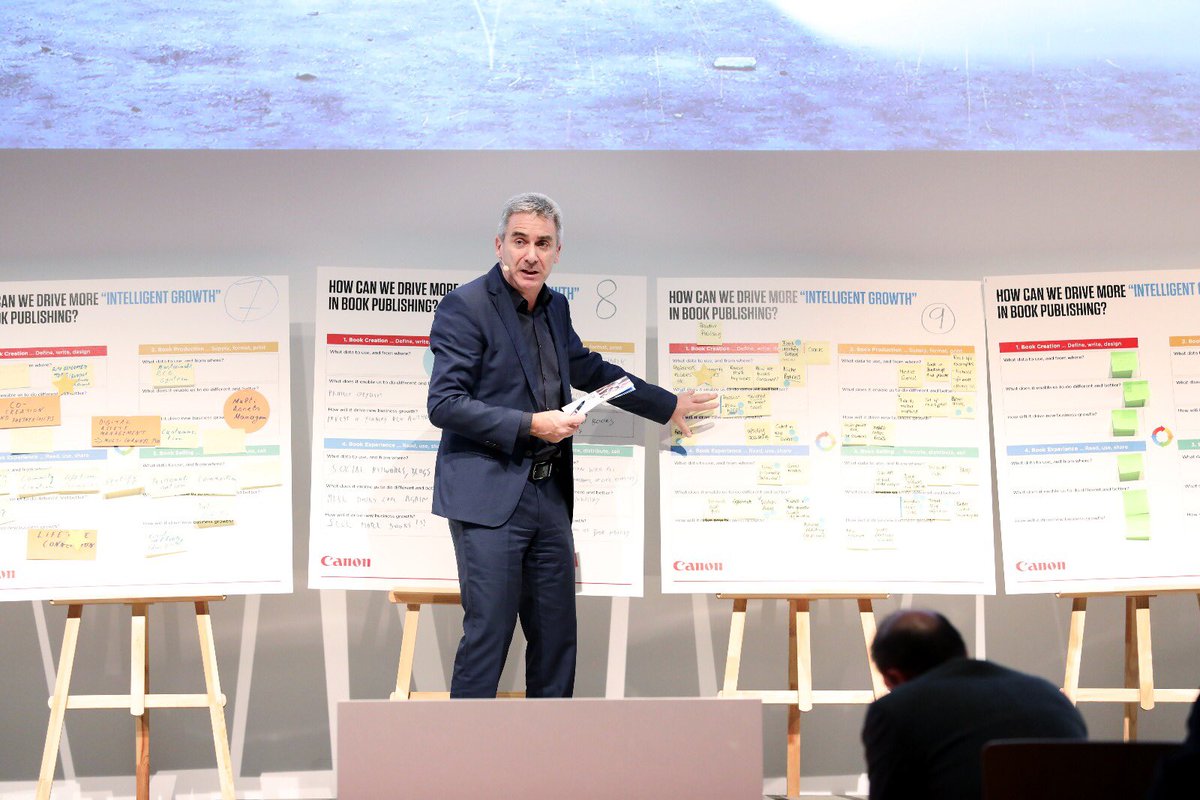
Below are some of the most useful resources which I use, both developed myself over the last 30 years running workshops with teams all over the world, and from a wide range of expert partners:
Future Lab is a structured facilitation process for workshops, or sometimes a series of workshops to develop new ideas, strategies, innovation and more, combining clear structure with embedded tools.
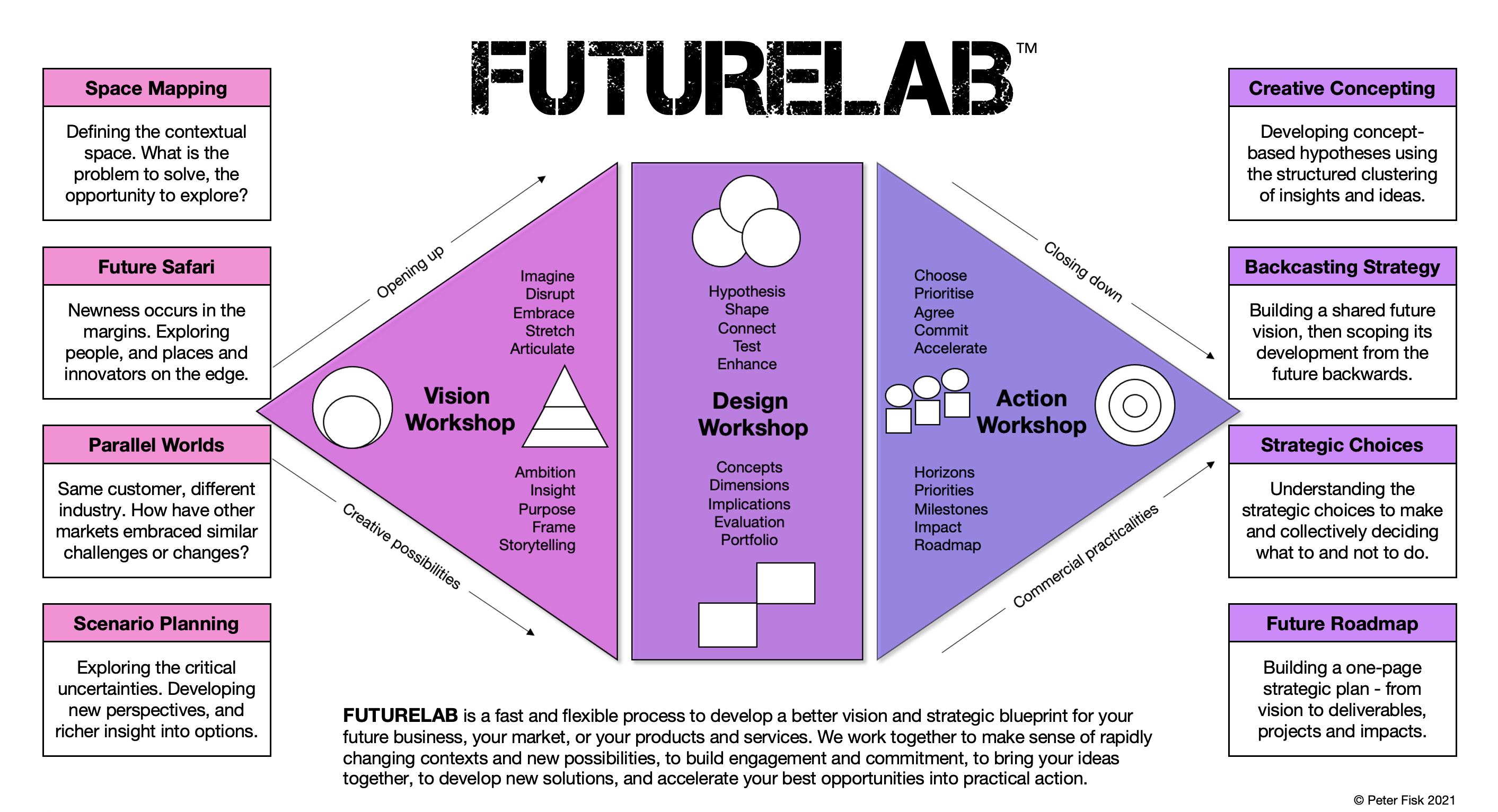
Gamechanger Labs are a portfolio of 16 business canvases, or templates, to explore the future of your business – from vision and strategy to insights and innovation, to leadership and culture, based on Peter Fisk’s best-selling “Gamechangers”.
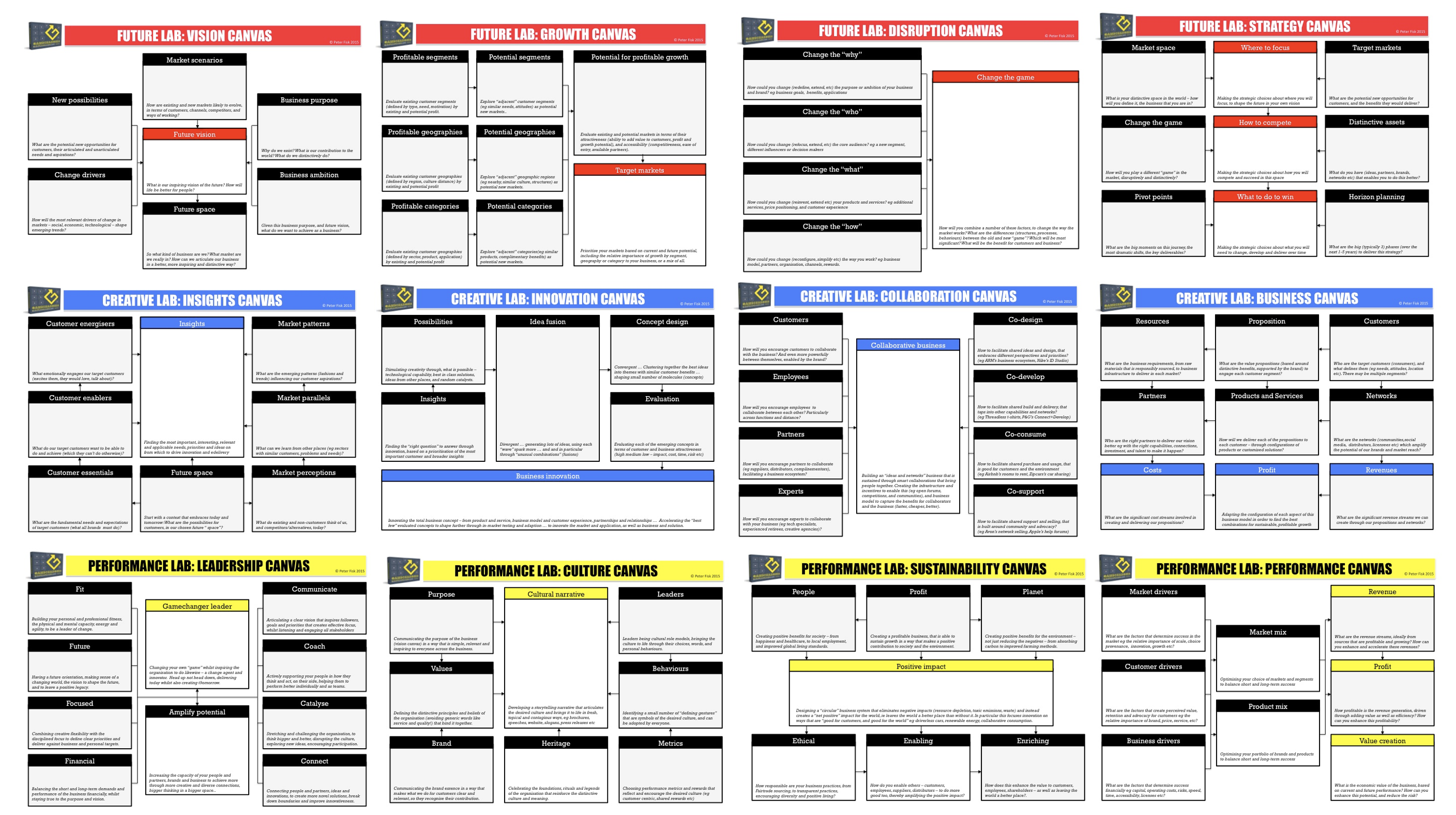
Sitra Futuremakers Toolbox from the Finnish government innovation fund, helps you recognise trends and emerging phenomena, imagine alternative futures and link your future-oriented thinking to change-making.
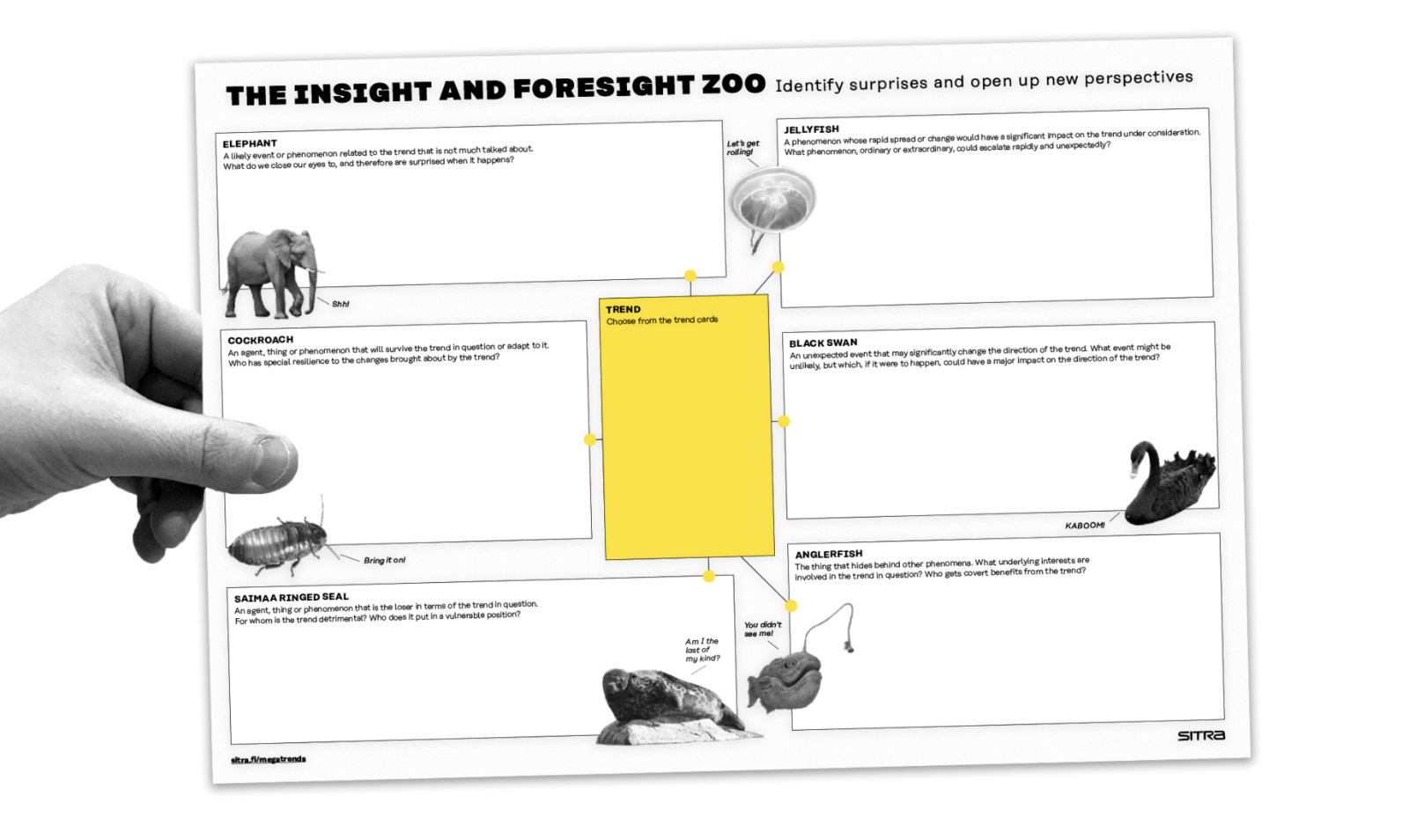
Strategyzer Toolkit with some of the best ideas, learnings and methods from Alex Osterwalder and his team, most famous for the business model canvas, to help you further your understanding and practice of innovation.
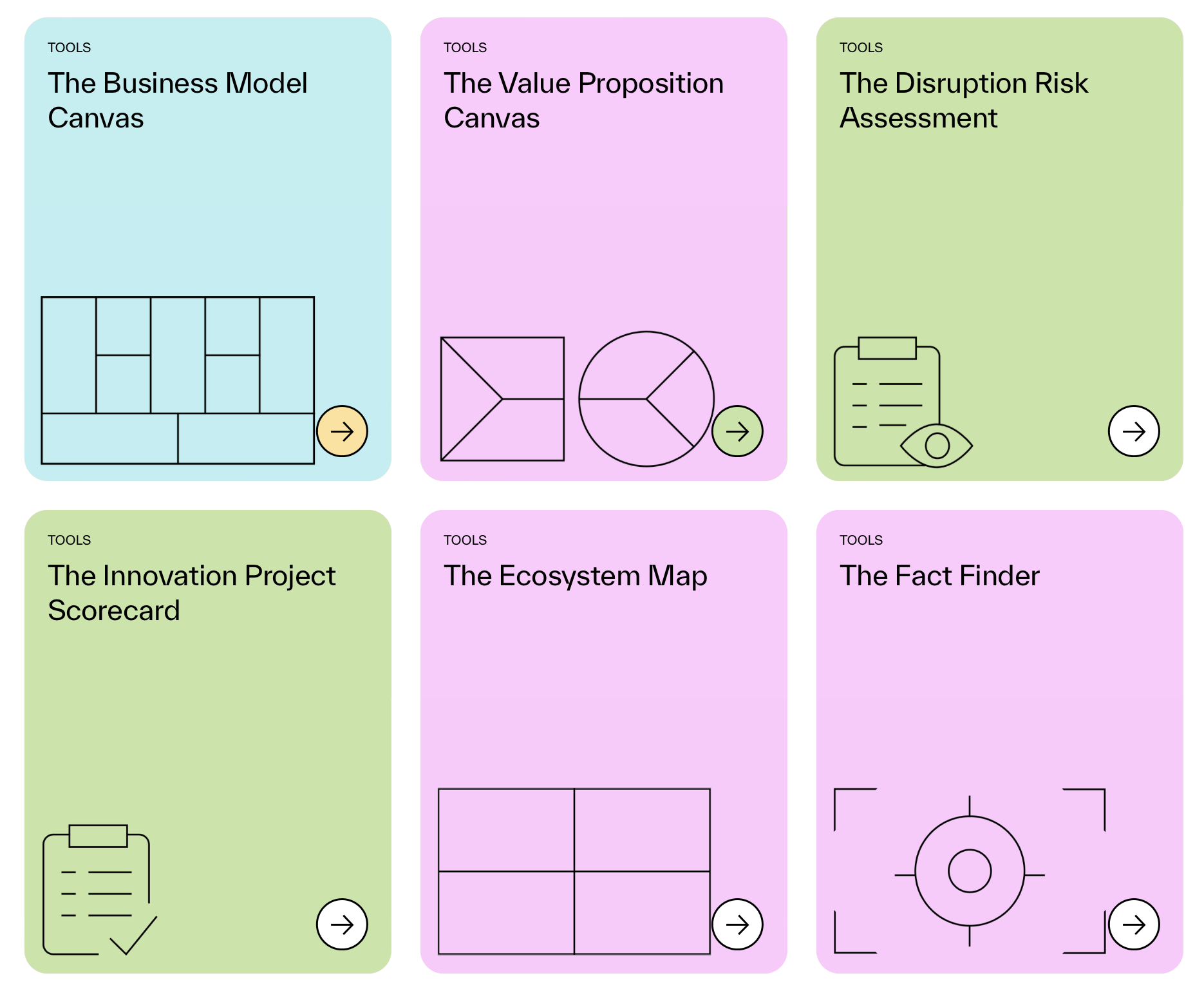
IDEO Design Kit. Human-centered design is a step-by-step guide from David Kelley and the IDEO team to unleashing your creativity, putting the people you serve at the center of your design process to come up with new answers to difficult problems.
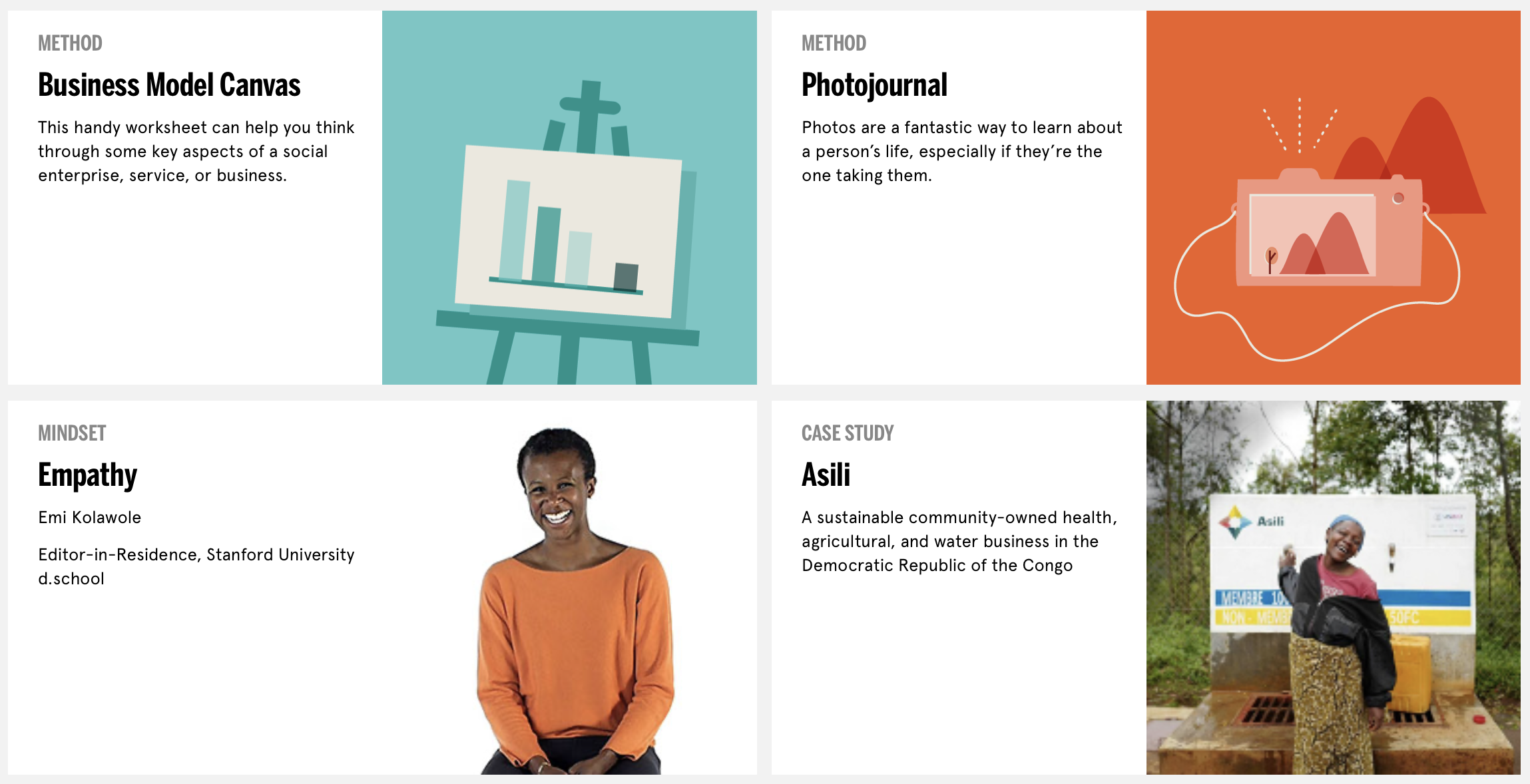
Design Method Toolkit is a comprehensive resource for designers of all levels, providing a well-organised and easy-to-use overview of the human-centred design process, from research to creation.
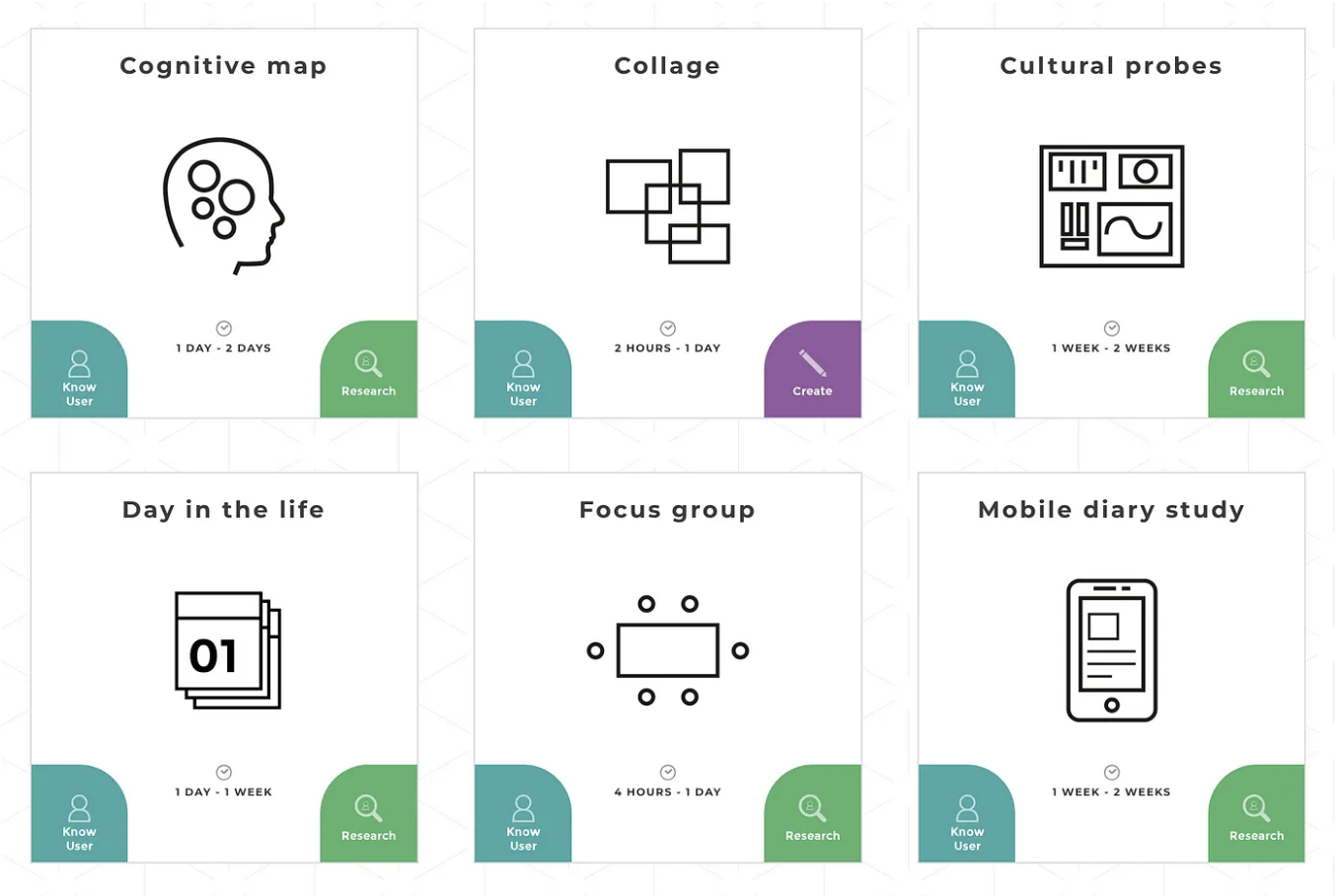
The Hyper Island Toolbox is a collection of methods and activities that focus on experiential learning, collaboration, and real-world problem-solving.
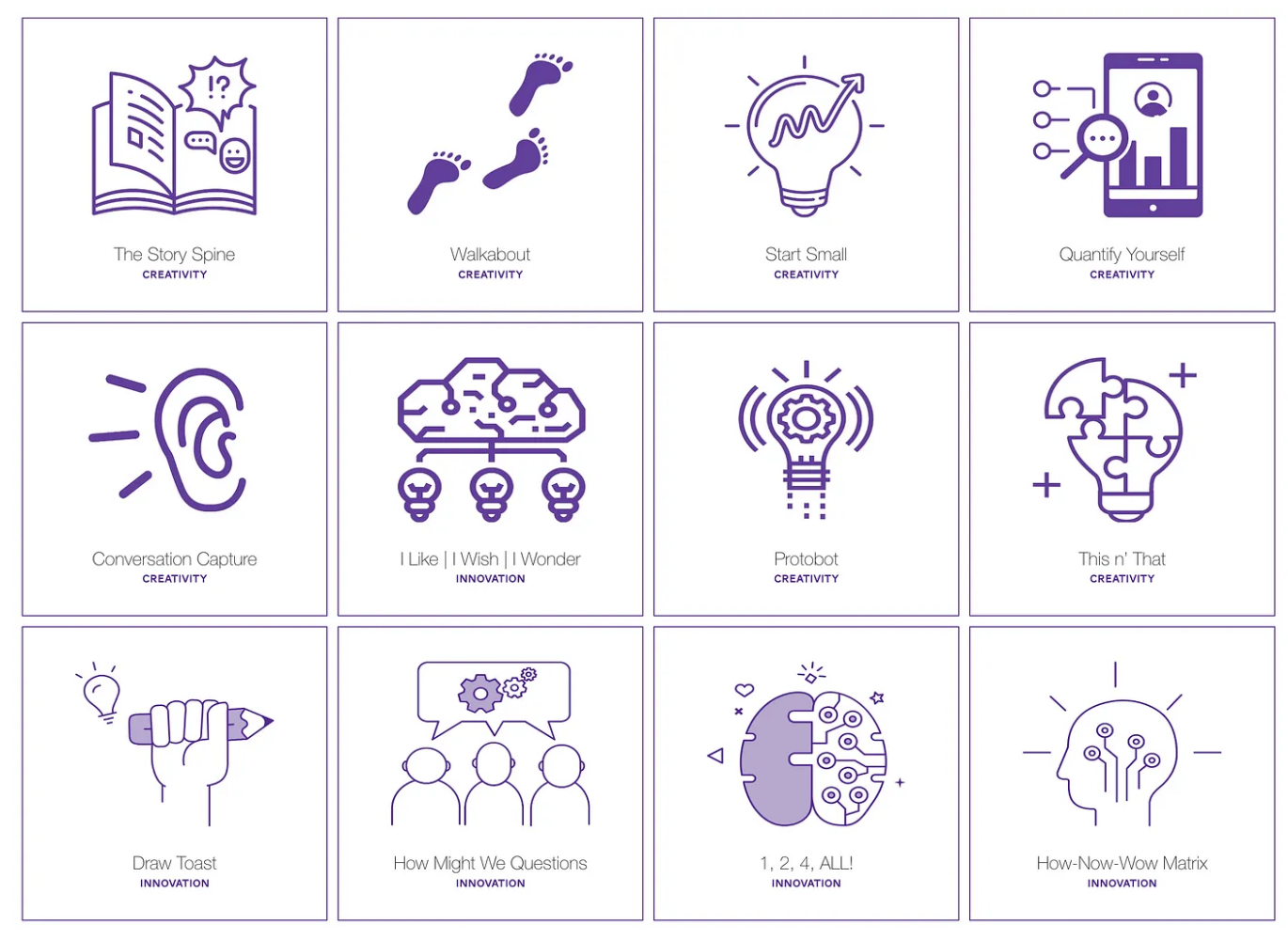
XPlane Change Toolkit, the visual sense-making company established by Dave Grey is known for producing fabulous infographics that interpret complexity in smart and simple ways, and now offers a wide range of worksheets
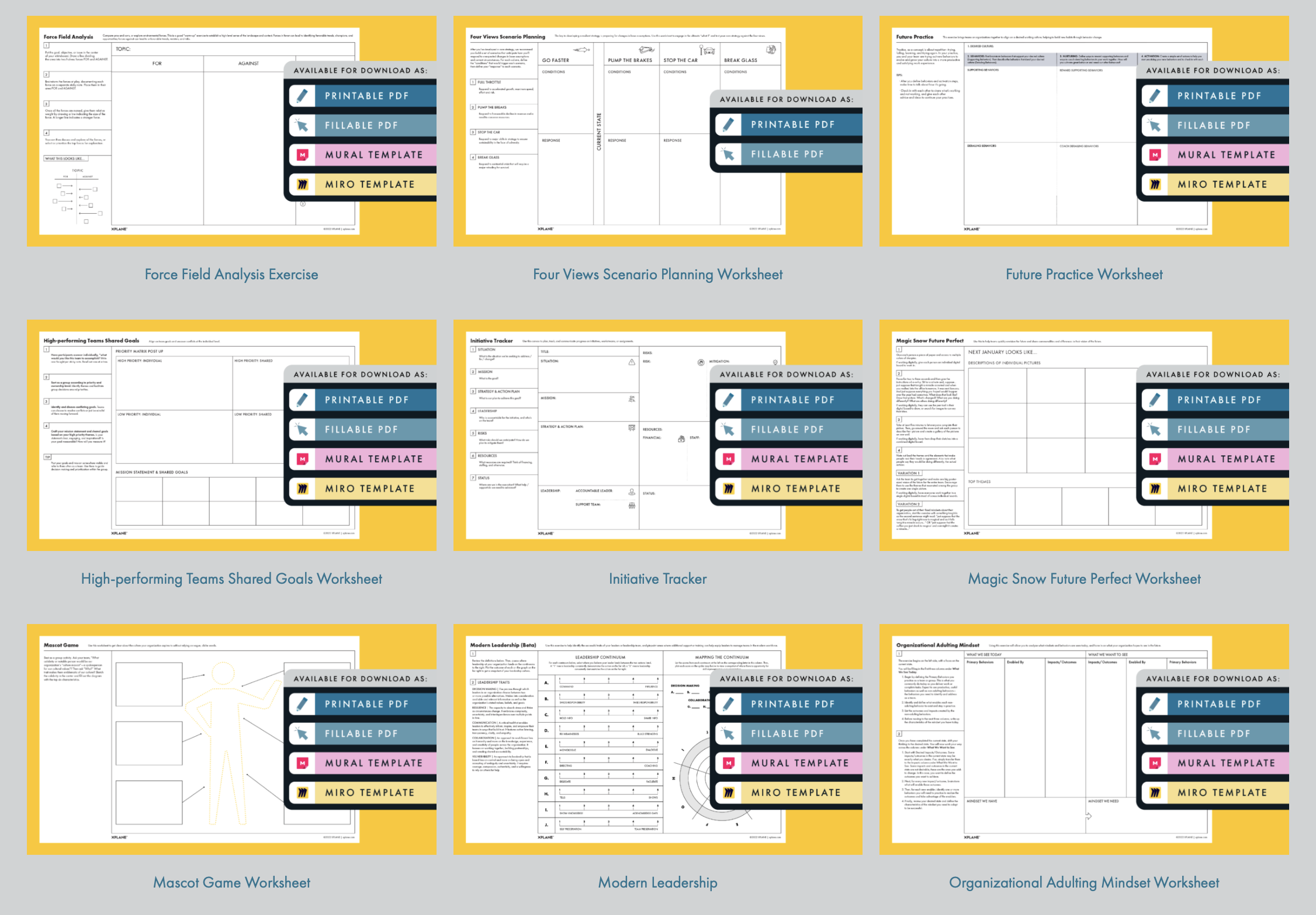
BOI Innovation Toolkit brings together more perspectives on business innovation, including some great case studies, and also a range of tools to make the case for radical change.
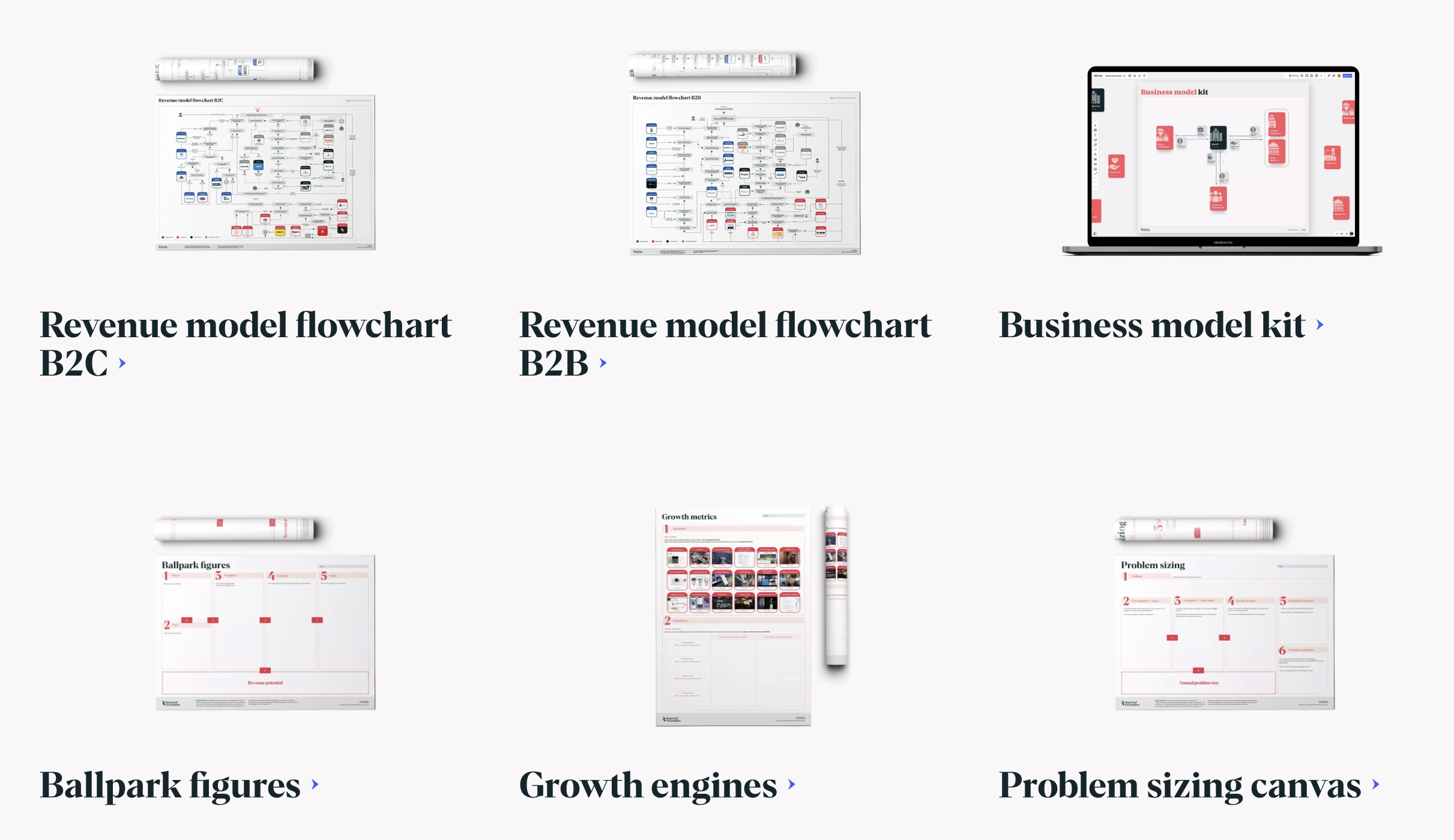
Circular Business Design Guide helps business leaders identify circular opportunities and design business models that create, deliver and capture value in ways that also benefit society and the environment.
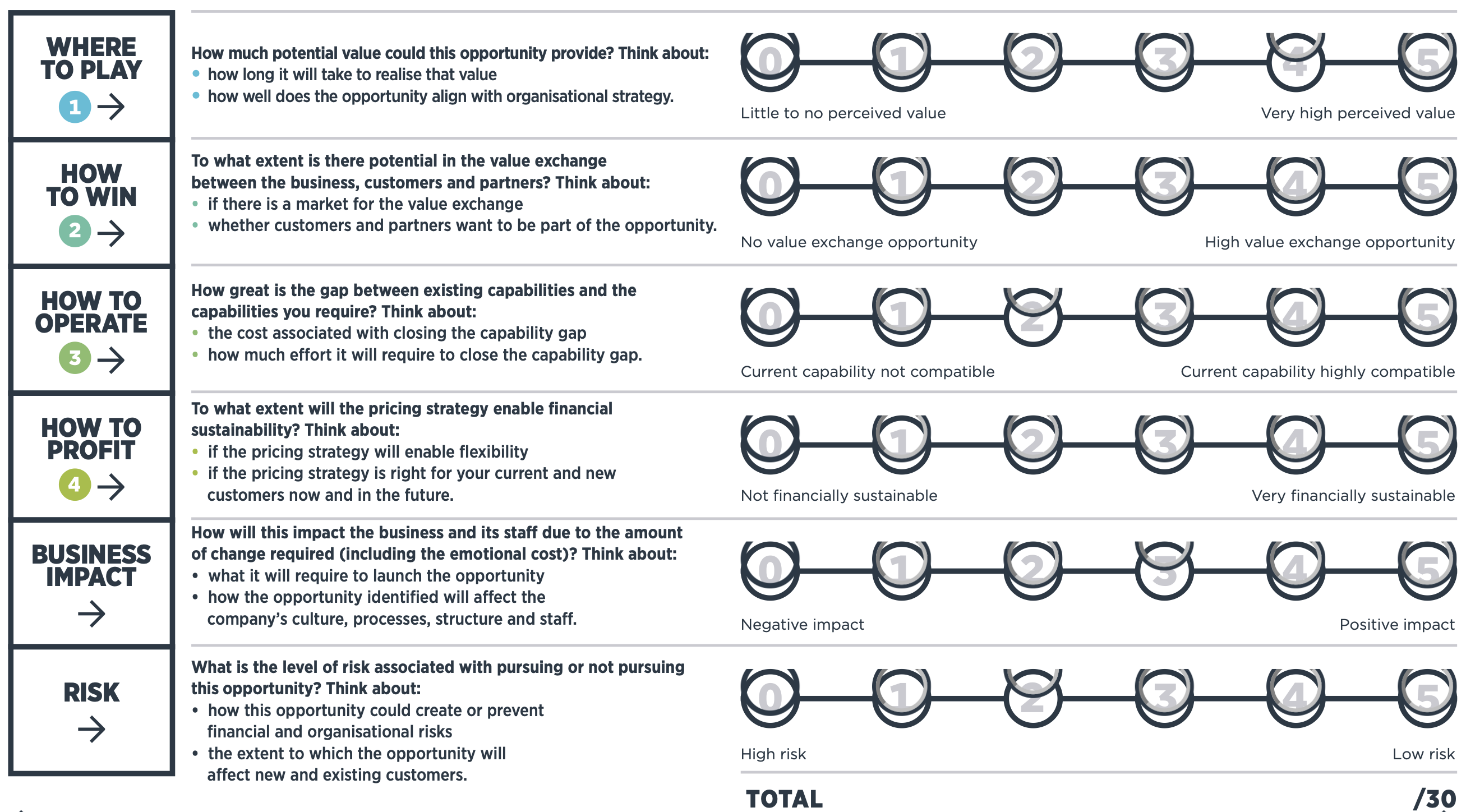
The Atlassian Team Playbook is a collection of workshop resources that help teams work better together. It includes a variety of tools and activities to improve communication, collaboration, and problem-solving.
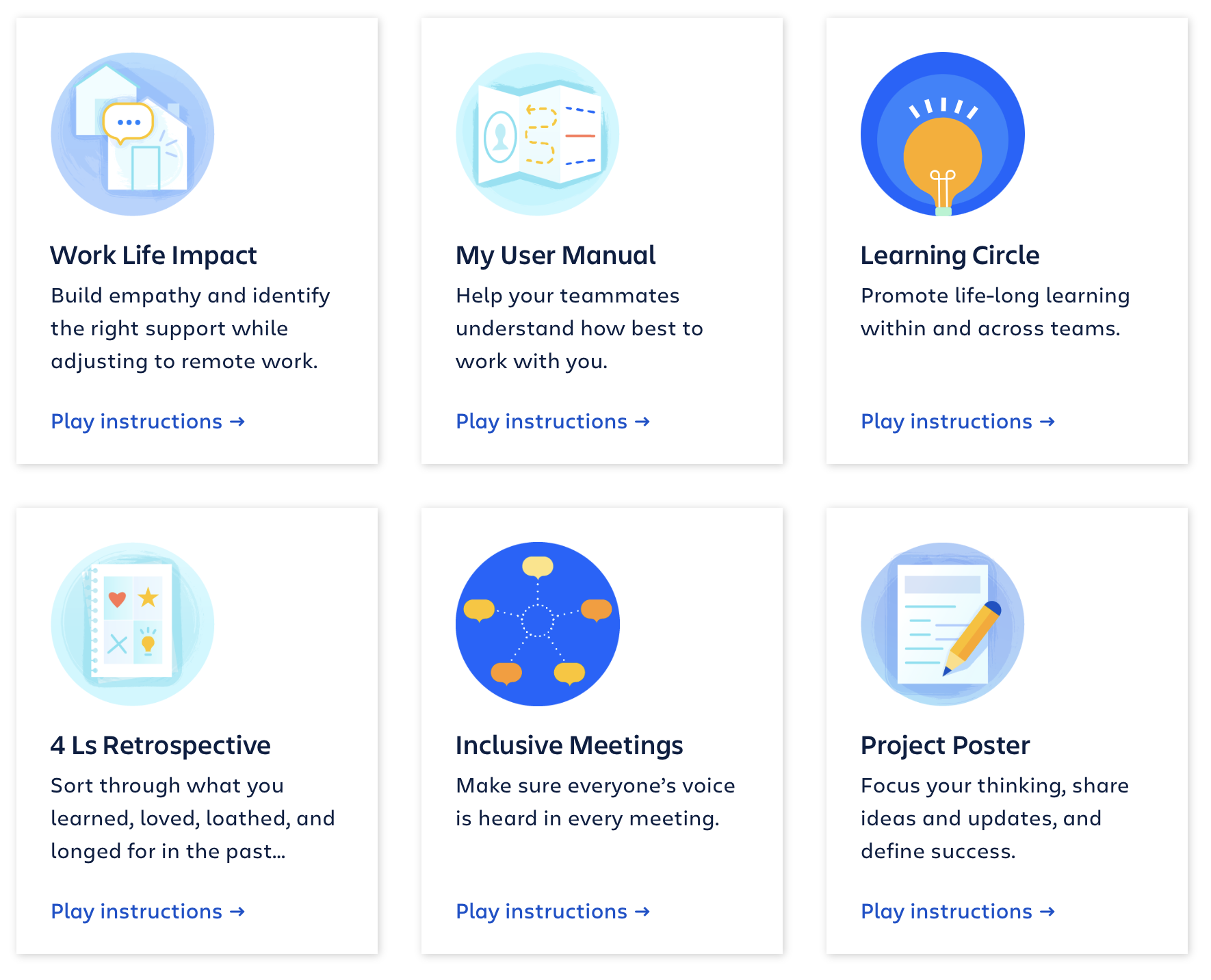
Nesta DIY Toolkit is more specifically for public-sector organisations, governments and agencies, starting with a flowchart to show how the many tools fit together. It’s designed for public-sector, but actually works for any kind of organisation.
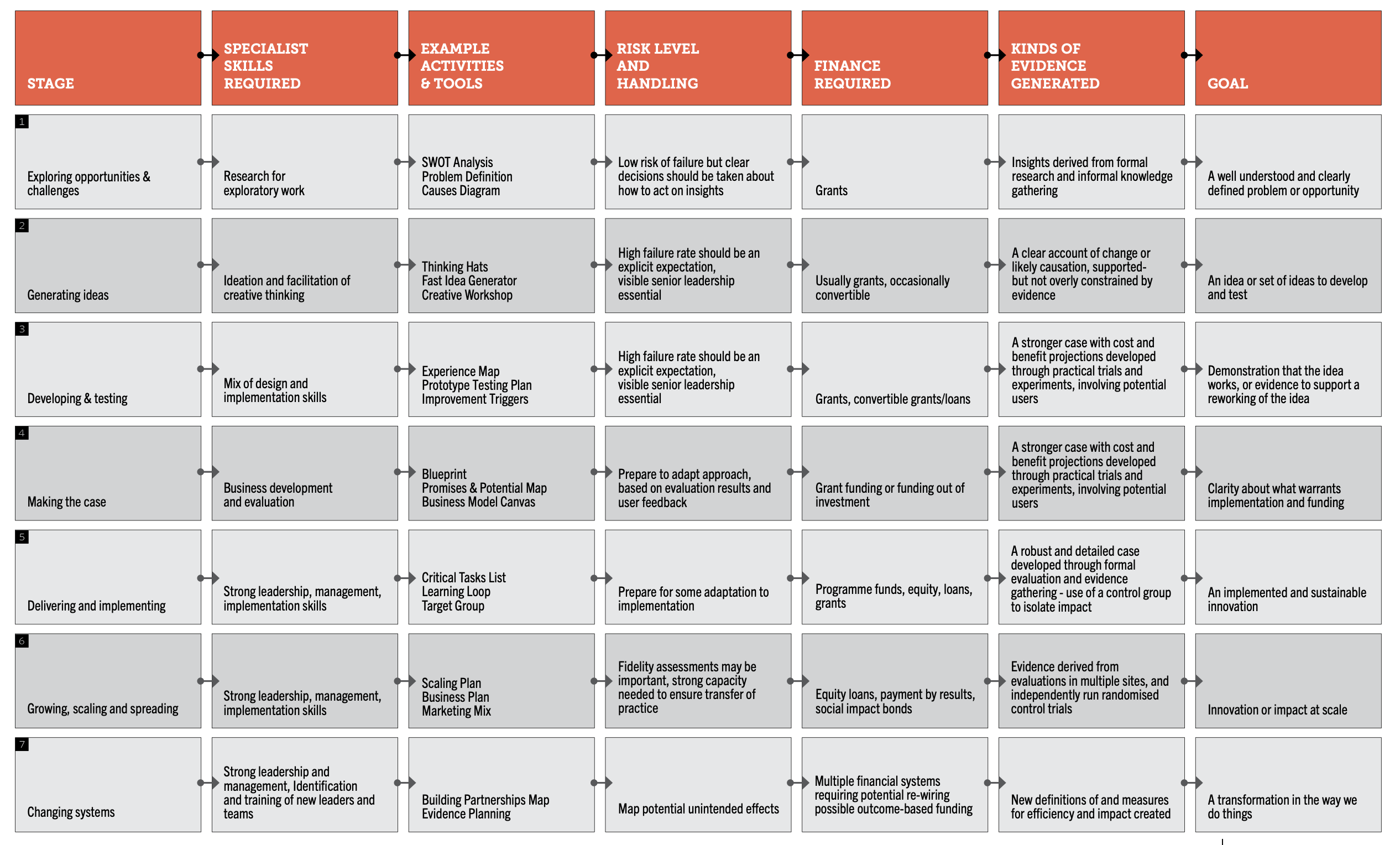 Business Futures Project brings over 300 resources together to help you build a better future, from the best books and articles to case studies and reports, tools and templates, videos and much more.
Business Futures Project brings over 300 resources together to help you build a better future, from the best books and articles to case studies and reports, tools and templates, videos and much more.
